Australian
and international
exploratory
performance and
media arts
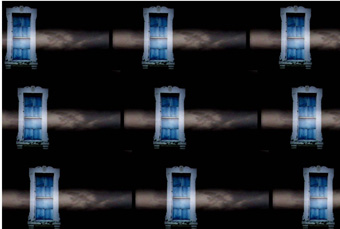
a thousand doors, a thousand windows
image cazerine barry
a thousand doors, a thousand windows
The curious history of windows (pondered by Bachelard, Virilio et al) and their metaphorical standing (windows on the soul; windows as eyes) are called to mind by Xenia Hanusiak’s A Thousand Doors, A Thousand Windows, a multimedia recital for soprano, recorded musical and electronic scores, and projected video imagery.
The Barn at the Historic Rosny Centre has no windows that we can see, just big wooden doors, a high timber rafted roof and richly textured, unadorned stone walls. We are enclosed in its darkness, our ears this time are the windows to whatever we might conjure from the musical creations of Xenia Hanusiak and Constantine Koukias. Yes, there’s a little stage business (occasional movement and gesture from Hanusiak) and video projections (alternating between blandly literal and irritatingly opaque), but the real drama of these works is in the singing. Hanusiak adroitly negotiates the demands of the composers, Hobart based Koukias and the Paris based Finnish composer, Kaija Saarahio, both requiring the soprano to plunge from ecstatic soaring to spoken and whispered text, and to leap back again to the heights. As well, the scores that Hanusiak sings with and against are far from the traditional notion of accompaniment—they merge into eerie wholeness ostensibly musical elements and recorded and created sounds.
Koukias’s Incantation Echoi II (1996) focuses on “the enunciation of pure vowels”, the open-mouthed, uncluttered tools of spiritual transcendance in ancient Christian and other ritual, here felt in passionate cries as well as lyrical flights in the big church ambience that is electronically provided. Lohn (from afar) (1996) is from the first part of Saariaho’s wonderful opera, L’amour de loin, in which a Christian prince in the European Middle Ages corresponds and falls in love with an Islamic princess in northern Africa. They never meet—he dies on the journey—but their relationship has evolved with an ecstatic intensity, here amplified by words sung, spoken and whispered in a shimmering percussive world and echoed with voices off in Occitan, French and English and ending in a heaven of bird calls. Appropriately Hanusiak holds the red-bound score, reading it (the text is the work of a mediaeval troubador) as if a letter from the lover prince. The singing is supple, full-bodied and finely integrated with the recorded material.
A Thousand Doors, A Thousand Windows (2003-04) is a work written and devised by Hanusiak and composed by Koukias. The text has the simple imagery and the aphoristic quality of ancient Arabic and Persian texts: “Do not shut the door/ The excuse is more shameful than the offence.” The authors write that their work is about estrangement and “the need for stillness and contemplation”: “The traveller in the journey knocks at the door seeking acknowledgment and a sense of sanctuary.” They find their inspiration in “the Call to Prayer and the Christian Ringing of Bells”—the bell sounds and a haunting church organ provide anchors in a world of uneasy electronic detail and dark vibrations further tempered by Koukias’ entrancing Greek Orthodox and Middle-Eastern musicality. Hanusiak engages with the condition of the traveller, from whisper to full-throated passion, singing with her own multiplying voice.
The three works of this concert were indeed like windows on the soul—one soul full of yearning for grace, for love, for acceptance; one soul achieving moments of hard-won transcendence in a musical cosmos of unexpected, beautiful sounds.
“Even in an academic context I would never talk about the work of et al, still less ‘explain’ it… the process of viewing art provides the explanation, and it is invariably particular to the viewer. The artist is exactly the wrong person to explain their work…”
This statement by dr p mule (sic) on behalf of the collective, et al. is a telling introduction to the show by this New Zealand group entitled Maintenance of Social Solidarity.
Mounted in CAST Gallery, the oppressive atmosphere of the installation is established immediately by the deep grey walls and ceiling. While the construction of individual objects is rough there’s a strong sense of deliberation and formality to the arrangement of elements within the space. At the entry, I’m confronted with two rows of easels facing each other. I hear a kind of chant bleeding from the other side of the room. Each of the easels displays a poster that has been defaced by cut and paste and packing tape then overlaid with thick, dark, handwriting. This text is like an abstract poem that triggers thoughts about war, solidarity and human rights abuse without really saying anything:
Degrading treatment is
never
Hostility hate
& contempt
day of dooms
a morally
permissible
option
infidel
Hanging from each easel is a set of headphones with soundtrack, the overlaid digitised voices immediately reminiscent of Stephen Hawking. These voices relay excerpts of speeches from key figures in the current war in Iraq, the war in Afghanistan and responses to 9/11. Stripping the actual voice and intonation of the speakers—George W Bush and Osama Bin Laden are featured—places each on the same platform for debate without the prejudice or limitation associated with language or accent. While the idea is interesting, there is a generic quality to the soundtrack –I quickly return the headphones—I feel like I’ve heard it before, another exhibition, other artists.
The remaining elements in the show hang together as one. In the centre of the room a cyclone fence encloses a large projection screen. Twelve chairs sit under a spotlight in their own cell—taped markings on the floor—as if to house a jury or audience at an execution. A desk is lit by a bare bulb like a monitoring station in the midst of the gloom. The chairs and desk also suggest presences that watch and wait. Three more easels sit beside the twelve chairs and on the wall behind them is a grid of images that map mathematical equations, again, defaced by loose, hand written text.
Within the fenceline, the projections are from Google Earth. In digitised tones I hear—“Stockholm”, “Cairo”, “Frankfurt”, “Washington”, “Baghdad.” The projection responds, spinning across the surface of the earth in that familiar Google way before settling just above an airstrip, as if about to land. At first I thought it searched out actual locations, but after a few repeats of the loop, I realised that these were fictionalised places where all else but that which immediately surrounds the airstrip seems blurred, missing or perhaps obliterated. It is as if I am witnessing a series of virtual airstrikes, perhaps from a simulated cockpit. At a certain point in the recording, most notably after “Baghdad” is uttered, the screen freezes and the recording switches to the haunting chant I heard upon entering the space. Given its Middle Easter edge, I read this like a prayer sung prior to attack.
I feel as though I’ve stumbled into a military monitoring or strategy room. From what little I can find about the secretive collective et al., this show is both typical and unique. The consistent aesthetic, the deep grey paint and the elements that appear to be modelled on some militaristic institution are typical. What is not is the minimalism of this piece – the group is known for using a mass of outdated sound and screen technology, quite often to build a cacophonous atmosphere. The use of headphones here allows the sole soundtrack to dominate and the space is easy to read in its arrangement. Given the introduction suggests the work should stand alone, I expected to be able to come to some sort of conclusion about it, but this obtuseness is also typical of et al. While I don’t feel like I’m treading any new ground I am intrigued by this show and the visual imagery—quite beautiful in its own way—stays with me.
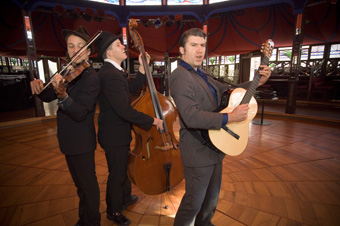
Mikelangelo & the Black Sea Gentlemen
photo Matt Newton
Mikelangelo & the Black Sea Gentlemen
The Nightingale of the Adriatic crooned and swooped in the crazy cage of the Crystal Palace last night, christened by the chants of the crowd The Baltic Stallion—they were swiftly corrected by the charming Balkan.
Mikelangelo’s statuesque form, clad in high black pants, danced in the mirrors beneath the chandeliers and disco ball of our devil’s kitchen. His voice soaked in sauerkraut, he truly was the devil sent from heaven. At one point, he enters the room like the Lone Ranger, guitar slung over one shoulder, dances on tabletops, caresses members of the audience, enticing even the most conservative of us into a fleshy sing-along—La, lah, lah, la, la. I left the show with blood thicker than wine racing through my veins, chanting La, lah, lah, la, la through Elizabeth Street Mall.
Mikelangelo and the Black Sea Gentlemen are a quintet—guitar, accordion, double bass, violin and clarinet. Each brings his own unique flavour to the mix—Moldavio recites a poem about his tragic downfall from taxidermy; an accountant who was sold to the circus as a child bellows a mournful song from the bar (“like love, sometimes the sweetest grape is the first to go rotten”); and Guido Libido suspends our disbelief in a fantastic short silent film sequence achieved simply with a screen and strobe light. The Gentlemen howl like dogs, crow like roosters and all openly and willing support their front man’s formidable persona.
Besides dubious Eastern European accents, the threads that bind these men are strong musicianship and a genuine sense of improvisation. Together, they radiate a lust for life. From the moment they enter the stage (and kiss each other on the cheeks three times) to the final encore (“seven hours worth of blood, sweat and tears in our home country but here rolled into three and a half minutes”!) there is a striking sense of humanity, a liveliness that opens up the possibility of even the humble potato becoming sexy.
Nothing is staged, rather it’s lived and shared. To be so genuine is risky but this is precisely what makes them so captivating. They embody a mock Slavic gloom and traverse a landscape in A minor where the sea leaves villages stuck in mud flats, where the weather is always bleak and where “we’re all just skeletons dancing in a sea of flesh”.
Mikelangelo demands attention like a Spanish bullfighter, and he and his Black Sea Gentlemen have written polkas for the 21st century that you won’t see on Eurovision.
All this and sauerkraut…I fear I may have become a groupie.
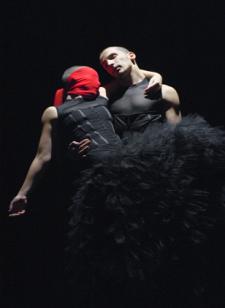
Mercy
photo Michael Rayner
Mercy
Mercy, the Raewyn Hill-Tasdance collaboration, proved curiously memorable, not the whole production, which problematically aestheticises imprisonment and torture into something quite beautiful (reds and blacks and columns of misty light evocative of fascist chic and movie concentration camps by night), but in a number of individual scenes and a final series that suggest a kind of narrative as an intimate couple go to their deaths.
The whole work, in its choreography, music and design is markedly formal. The brief passages of Pergolesi’s Marian Vespers determine the duration of each scene and evoke, of course, a religious formalism matched in the choreography by gestural imagery of supplication, benediction, crucifixion and pieta-like cradlings. Even their opposites—images of torment and torture—share a Baroque neatness, a dancerliness at times courtly and with evidence too of the balletic underpinnings of much modern dance. It’s when this formalism is broken or a series of images suddenly coalesce into something more potent that Mercy makes its mark in the memory.
A man, stretched out on the floor, wrestles with his chains but what disturbs is a sudden and repeated sharp stiffening of the whole body at the moment he puts his hands behind his back as if to have them bound. One victim struggles desperately in a swathe of red ribbon delicately wrapped about him by his tormentors. Another victim uses her body to plead with her gaoler, wrapping herself around him, climbing and clinging to him, losing grip to fall from his temporary or denied grasp. He catches her exhausted body one more time and she falls, totally and frighteningly limp, face down across his extended arms. He leaves her body behind. Is the gesture he makes one of perverted benediction? Another powerful image is of inert bodies carried in a slow dance across the stage, as if in rigor mortis.
Amanatidis and Dunn stand out in a somewhat uneven ensemble. Daniel Zika’s powerful lighting creates spaces both epic and claustrophobic. Greg Clarke’s costumes include identical bodices and striking skirts for male and female dancers (and the principals share short-cropped hair) creating ambiguity and dark elegance—creatures transcending gender and too beautiful to be destroyed. Unfortunately the balance of the costuming—bare-buttocked, leather strapped—looks the cliched stuff of S&M fantasy, reinforcing a feeling that the content of the work is at the mercy of a sleek aesthetic that undercuts the immediacy of its concerns—fortunately not always.
In a final series of images, Derek Amanatidis dances a remarkable solo of supplication, arms reaching high in a convincing embodiment of prayer, circling low
and returning again and again to stretch up for grace. Amanatidis and Trish Dunn whose bodies have hitherto remained apart but are drawn to one another now entwine in movements of subtle caring such as the gentle cradling of a head. The two separate and lie passively on the stage as a row of torturers advances slowly on them. There is no mercy here, perhaps only in the care they have shared and a dream of grace for those who believe in God’s beneficence—a distant prospect here for all the beauty of the music and the empathy of the choreography. Mercy is at its best when its images of suffering, supplication and caring are at their strongest, when the extremities of torment and yearning are palpable in the dancers’ bodies.
The major retrospective of Leigh Hobba’s work currently at TMAG offered the opportunity for live performance, and the potential was not wasted. Live work has formed an important part of Hobba’s practice since 1996 when he was involved in a number of collaborations at Adelaide’s EAF. This performance was a kind of ‘greatest hits parade’, as Hobba noted when introducing the work and himself. This disarming moment thankfully lightened the tone, which had become tense as an assembled audience of museum patrons and Tasmanian Arts intelligentsia scrambled for the limited seats. This was to be an event.
What then transpired was a gloriously ragged presentation of individual works that moved in and out of each other, creating a serendipitous whole that was strikingly engaging. There certainly appeared to be accidents and human error, but this added an element of informality that freed the work from being a mere rehash of past glories—here was a whole made of parts, like the stark self portraits of Hobba visible elsewhere in this retrospective. Not quite new work, but not a bloodless retread.
Variations 1, a work from the beginnings of Hobba’s practice was deemed the sensible place to start. Its striking use of shadow and the introduction of circular breathing—a technique of playing long, extended forms without interruption—was immediately arresting. This was ritual. Light and dark playing on the wall, the performer hidden yet totally audible, his disembodied silhouette huge, the image of his clarinet extending out to a vast length, every small movement exaggerated.
Unsure where one piece ended and the next began I gave up trying to decide: yes there was a change of pace here, the mood perceptibly shifted, Hobba spoke of Tasmanian tiger hunters, revealing how spoken text figures in his varied palette. Dancer, Wendy Morrow, a frequent collaborator took the stage and the focus for a time, but the sensation that every moment was an extension of the work prior, a growth out of it, was hard to shake. There was progression in the changes as the onstage monitors blinked awake, almost independent of the actual performers, they seemed to have a life of their own, competing for attention. Screen images were being triggered from assistants in the audience, yet the appearance was random, and the question of technical mishap seemed to hover—was this the intent? What was I seeing? And what was I hearing in the gorgeous trilling arpeggio that ended the piece as Hobba wandered out of the room and into the distance? He seemed elated somehow as he took in the applause, waving his clarinet in a gesture of triumph. Something had been achieved, something with deep significance to the personal world Leigh Hobba investigates.
The curatorial premise is promising. Free Range is an exhibition featuring 28 of Tasmania’s leading designers and their prototypes and one-off pieces of jewellery, furniture, sculpture, lights and ceramics. It claims to provide “…a rare opportunity for the participants to venture outside of the constraints of the designer/client relationship and to try something new or different.” I was hooked by this proposal and excited to find out what results when the creativity and imagination of skilled craftspeople is let loose. My hope was that it might be something truly original, aesthetically challenging, and possibly fabulous.
Unsurprisingly perhaps, given that the show is presented by Design Objects Tasmania, all works are object-based. Nevertheless, there is a contingent of works which range into conceptual or artistic territory. I was drawn to these pieces as they represent the furthest deviation from designers’ usual concern for functionality. Textile artist Grietje van Randen for example creates a very tactile full-scale replica of a potbelly stove. It’s made entirely from felted white merino wool and comments on lifestyle habits exacerbating global warming, and urges us toward sustainable living. Ceramicist Zsolt Faludi contributes Three Islands, a beautiful sculpture of clay, glaze, glass and resin symbolic of the hermetic nature of island culture. Rebecca Coote’s two light objects (the largest sized 100 by 80 centimetres) are tentacle-like architectural installations of glass that wrap around corners and dangle from ledges, while Martin Warren’s intensely coloured slumped glass baskets stretch down from above like cooling toffee. These pieces reflect artisans taking delight in challenging the physical and visual potential of their media, as well their own skill.
Furniture is perhaps the most conservative category of works in this show. A number of unchallenging but nevertheless elegant table, seat and cabinet designs feature the precious indigenous timbers (such as Huon Pine, King Billy Pine and Celery Top Pine) ubiquitous in handcrafted Tasmanian furniture at present.
Patrick Hall’s Typeface is a notable exception. A visually heavy, boxy structure 1.8 metres in height, this piece grapples with recollection through the form of an archival cabinet filled with drawers. The collection—ceramic fragments illustrated with photographic images of faces, labelled with strange catch phrases—are not hidden inside but encased behind glass in the drawer-fronts themselves. This exquisite and conceptually complex object evidences Hall’s statement that his practice “is based in craft, is informed by design, but deals with ‘fine art’ concerns.”
Peter Prassil’s Recreational Device is a reclining lounge chair of aluminium, stainless steel and black leather, gadget-ed with microphone and amplifiers. Stylistically sitting somewhere between a dentist chair and the space age interior designs of the 1960s, this furniture piece also stands out for truly shaking off concerns of practicality and commercial viability in favour of fantasy.
The setting of Mawson’s Waterside Pavilion, a purpose-built design showroom, ensures this exhibition maintains an industrial feel. It could have been interesting to view these pieces in a gallery setting, and a number would certainly have benefited from controlled lighting. Alternatively it would be wonderful to actually sit in Prasil’s chair and find out what the microphone and amplifiers did, or to see Megan Perkins leather belts with luscious enamel buckles modelled.
As it is, these disparate works are collated in Free Range almost like an expo and not quite like an art exhibition and as such fail to capitalise on the opportunities of either format. A picture of avant-garde practice from the creative hybrid zones beyond commercial design is not quite realised overall, yet I sense Kevin Perkins could have addressed this to a degree through stronger curatorial direction. There are undoubtedly many very beautiful objects in Free Range and if I think of the show simply as a loose survey of creativity in contemporary local design, it is an excellent indication of the breadth and vibrancy of the industry here in Tasmania.
The Hobart Chamber Orchestra and Tasmanian Chorale’s concert for Ten Days on the Island lovingly entwined the music of Britain’s Henry Purcell and Ralph Vaughan Williams with works by Tasmania’s Don Kay and Peter Sculthorpe in an engrossing program that for good reason felt more British than Australian. That’s largely because Kay’s Matthina in the Red Dress and Sculthorpe’s My Country Childhood, despite local references, evoke the pastoral tradition of British music (Delius, Bax et al) in the finely modulated long lines of their writing for violins and violas and the darker, often telling underpinnings from cellos and basses. The Kay is inspired by an 1842 portrait by Thomas Bock of a young Aboriginal girl in an elegant dress; the Sculthorpe ‘country’ is in part the Tasmania in which he grew up.
A copy of the Matthina portrait sits to once side of the orchestra in the Town Hall, the girl’s apparent serenity and the quiet directness of her gaze captured in the gentle lyricism of Kay’s composition. There’s nothing programmatic about the score, but there is a gradual if always subtle darkening of mood from the cellos, a few sudden silences, like a dance interrupted, and some later plucking and then firm bowing of the double basses (perhaps a moment of disquiet about what the composer sees in the portrait), ending softly and fading with just the slightest hint of discordance. It’s a work more about the viewer of the painting than its subject—there’s a certain elegiac quality although none of the melancholy of nostalgia.
The Four English Folk Songs by Ralph Vaughan Williams are an acquired taste, but the Tasmanian Chorale under the direction of Stephanie Abercromby acquitted them with ease, attentive to the complex layerings with which Williams embroidered and sometimes laboured such simple songs. Their interest resides in part in juxtaposing them with Purcell’s Dido and Aeneas, the first English opera, written some 200 years before the Vaughan Williams and presented in the second part of the concert.
Sculthorpe’s My Country Childhood proved a fine companion piece for the Kay composition, opening in a similar way in part one, Song of the Hills, with a fetching iterated melody and a slight darkening from beneath before a solo violin sings out above the rest. Part two, A Church Gathering, although warmly contrapuntal, evokes a sense of yearning and again the solo violin rises heavenwards. In part three, A Village Funeral, cellos and basses brood, the cello this time dominant in a kind of keening followed by a surge of affecting anguish, heightened by the violins and concluding with diminishing cadences of the same hurt—death now almost accepted. Finally, in Song of the River rapid soft fiddling provides a sense of a speeding current over which run slower waters suggested by a melancholy cello before the whole speeds up in almost frantic ripplings—it’s a wonderful dance of a river as much as a song.
Conductor Myer Fredman paced Dido and Aeneas at the speed it warrants—brisk, allowing the spare drama to unfold without strain and for the listener to feel the considerable force of a string orchestra fattened out with harpsichord, an experience aided by the intimate, clean acoustic of Hobart’s Town Hall. The soloists were all in fine voice, Jane Edwards above all, her Dido heartfelt, unmelodramatic and the continuo playing (cello, Tony Morgan; harpsichord, Stephanie Abercromby) providing firm underpinning for the vocal action. The Tasmanian Chorale were allowed to display their full power and, in the sad final song, their capacity for nuance. This was not a period instrument presentation but the continuo playing and Fredman’s dance-like drive yielded the requisite crispness, elegance and passion.
Entwined was an unusual experience—a traversal of 300 years of music largely out of one tradition, moving broadly from the present to the past, and teasing out kinships between islands—sharing elegance, reflectiveness and a subtle dancerliness in these works. Then again, there was nothing like Sculthorpe’s Sun Music on the program to point to some palpable differences.
We live in a world of make-believe. We access more information than ever before but the technologies that make this possible can also blur our vision of reality. We are under the misconception that information is knowledge. We become insecure and, as we struggle to connect a constructed view of reality with our own lived experiences, ours is no longer a shared reality but a shared ‘dis-reality.’
The strongest point of audience engagement with et al.’s Maintenance of Social Solidarity appears to be in unpacking the theories it presents. The exhibition notes present six introductions to the New Zealand collective which investigates our systems of belief and defines our current state of disconnection. Etal suggests our freedom is at stake when we can no longer choose what we see and hear, perversely distorting our image of the ‘real’ world.
The room is set up like some self-ordering information bunker. The walls are gun-metal blue and a high wire fence encloses a large projected image of the Google map search engine, constantly scanning city to city around the world. As we zoom in on landscapes (bunkers, airstrips and military installations) devoid of any cultural detail, a computer animated voice tells us where we are. This sense of removal is a reccurring theme in the work. Through various technological means (headphones, projectors, laptops etc) we are reminded that ours is a constructed reality that we do not control. Political jargon and religious discourse rather than geography keep us distant from other peoples and lands, generating a sense of us and them and consequent insecurity.
A section of the space is set up with a series of easels to which are pinned large printed posters that have been defaced by a variety of packing and adhesive tapes. Each easel has a set of headphones attached. Some have a mouthpiece so you feel like a scud missile launcher when you put them on. But the mouthpieces don’t work and so the potential of dialogue becomes monologue as computer enhanced male and female voices speak in what first appears to be a familiar media discourse. It soon becomes apparent that the information we hear is mumbo-jumbo. Suddenly I feel angry, as if my time has been wasted listening to a distant rhetoric that pollutes my reality.
At the foot of each easel is a pile of street press style publications which you can take away with you. They are filled with abstracted imagery of sun-spots and quotes from George W Bush, Osama bin Laden and Saddam Hussein relating to God, freedom and change. Selected words in each quotation have file paths attached, abstracting them and making them seem computer generated.
Sporadic musical chanting is a reminder of our need to connect for more than just information exchange and heightens awareness of our isolation in a room full of technological equipment and computerised voices. Without being culture or gender specific, the Maintenance of Social Solidarity suggests that these notions of isolation and shared dis-reality are everyone’s concern. We are collectively, not individually, to blame for the displacement of our culture. By creating an awareness of how media and political middlemen make meaning for us we become aware of just how distorted our world view may have become. It makes me want to get straight to the source: to have a cup of tea and conversation with someone across the other side of the world and to hear about their reality.
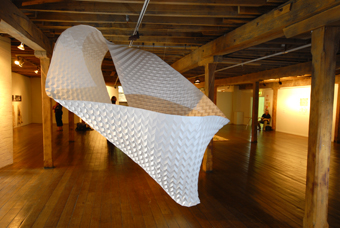
Alex Pentek, Otherness
photo Craig Opie
Alex Pentek, Otherness
Alex Pentek’s Otherness is a monumental metre-wide Mobius strip constructed from a single length of cartridge paper approximately four metres long. The paper sheet is brought into relief through a meticulous process of scoring and folding. Beginning as a repetition of diamond shapes the folded texture morphs into rounded scales before gradually returning to the original pattern. The loop and twist of the overall structure is simple and graceful.
Amidst the already eclectic range of work in the exhibition An Other Place, Otherness it is an odd entity to encounter. It is big, white and its place within the exhibition concept is at first obtuse. Initially, I complacently assume I understand its investigation: something along the lines of a formalist pursuit of perfection. And I am only vaguely interested.
The sculpture is accessible from all angles and as I wander around its girth peering over its lip into its folds, I begin to realise I’ve been too hasty in judging it. Suspended on wires, it all but fills the volume of space between gallery ceiling and floor. In a dialogue of bodies I warm to this “white elephant” and begin to notice its surprising subtlety.
Natural light passes through the semi-opaque paper, bouncing off and between its surfaces. The interior has the luminescence of a seashell from some angles and elsewhere the gallery’s lighting throws facets of the paper into contrasting yellow and shadow-blue. Disturbances in the air trigger a gentle bounce across the paper structure, a reminder of the material weightlessness of Otherness.
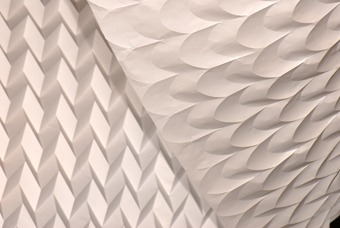
Alex Pentek, Otherness (detail)
photo Craig Opie
Alex Pentek, Otherness (detail)
Crinkles, dents, small tears and holes made accidentally in folding mark the entire surface. No effort has been made to disguise the join in the paper strip, nor the reinforced attachment points of the hanging mechanism. Perhaps the artist was pursuing consistency and perfection, but this work is very much handmade and it bears testament to the fact that the artist is human not machine. The humility of the work renders the concentration, accuracy, care and persistence involved in the Pentek’s labour all the more potent.
An Other Place brings together three Irish and three Australian contemporary artists to explore the notion of ‘other in place’ (felt especially in island places) and curator Sean Kelly in his catalogue essay writes of the slippage between familiarity and confusion associated with this precarious state of being. This concept made tangible in the shifting pattern of Pentek’s work and the eternal loop of the Mobius strip is a powerful metaphor for transition occurring between assimilation and difference within one continuous entity. The play between inside/outside and the twisting that turns both sides of the paper outwards speaks of inversion and extroversion.
Pentek’s sculpture is a floating island: physically self-contained and visually at odds with other works in the show. Its scale makes Otherness impossible to overlook, yet its presence is paradoxically unassuming. What at first appeared a cold rather conceptual and self-referential work turned out, through interaction, to be sensual and receptive.
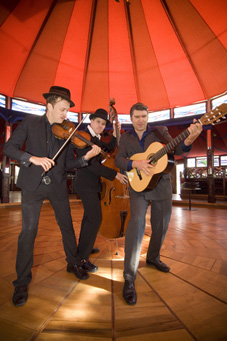
Mikelangelo and the Black Sea Gentlemen
photo Matt Newton
Mikelangelo and the Black Sea Gentlemen
Mikelangelo pauses to run a comb through his slicked-back hair “ This song is a rumination on gloom” he announces to the teary eyed audience. That’s right folks; don’t wear your mascara to this one. Mikelangelo and the Black Sea Gentlemen is an hysterically funny gypsy cabaret group playing at the Crystal Palace this week.
Mikelangelo is the handsome charismatic ringleader with a voice so absurdly deep that it competes with the double bass. Rufino the Catalan Casanova is a shifty looking violinist with the ability to jump onto tables without missing a note. On the clarinet is The Great Muldavio, a taxidermist on the run from an avenging duchess. Guido Libido, on the piano accordion, looks suspiciously like Uncle Fester (unlike the other Gentlemen, he refrains from singing because his tongue has been cut out in a battle over a woman and replaced with the tongue of a bull). Little Ivan, the bass player, may have been behind the killing of Mikelangelo’s entire family. These characters are completed with immaculate suits, intriguingly sexy European accents and morbid tales of their past.
This is black humour at its best. The truly macabre stories are told through monologues, dramatic re-enactments and satirical songs for which the Eastern European style arrangements are perfect especially for songs like It’s one of those A-Minor Days.
My favourite has to be A Formidable Marinade, a klezmer-themed tune. Besides the song itself which demonstrates the group’s expert musical and song writing abilities the melodramatics that accompany the performance are pretty impressive: Mikelangelo slides through the audience and between the tables like an animal possessed, while singing:
“Sodomy is not just for animals
Human flesh is not just for cannibals
I’ll feast on your body if you feast on mine
Blood is thicker and redder than wine
Lay ourselves out upon the table
Ravish each other ‘til we’re no longer able
When juices mix in the heat of the fray
It will make a formidable… marinade.”
At this point Rufino leaps onto a table and, ripping into his violin, plays a spine-chilling solo, his fingers climbing up the fingerboard to the bridge, higher and higher. The tortuously high notes truly make the described lust real.
The smoke and lights filling the circus tent- style venue provide the perfect stage for a group that enjoys interacting with the audience, jumping onto tables and visiting the bar mid-show (which reminds me: for the ultimate Gentlemen experience, make sure you have a glass of vino in your hand).
Their encore which they describe as a seven hour ordeal squeezed into three minutes of blood, sweat and tears, was rejected by Eurovision, and I probably don’t have to tell you that the producers haven’t any taste. I was trying not to mention the word taste but these are classy gentlemen. However dubious their subject matter, they pull it off, and they pull it off well. Although the band sound great on CD their utterly seductive show has to be seen to believed.
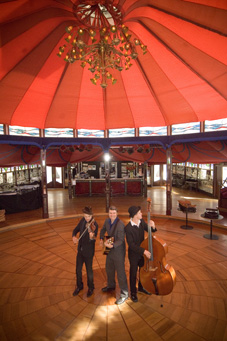
Mikelangelo and the Black Sea Gentleman in the Pacific Crystal Palace
photo Matt Newton
Mikelangelo and the Black Sea Gentleman in the Pacific Crystal Palace
It seems that you can’t have a festival in Australia these days without a Famous Spiegeltent. But sometimes there just isn’t one around when you need it, so an inventive New Zealander decided to build his own. Internally the Pacific Crystal Palace is faithful to the original—wooden floors, ornate booths, stained glass windows and mirrors—perhaps lacking the subtle sensation that generations of festival goers have lived, loved and caroused in its plush seats since the 1920s but including modern comforts such as insulation. Made of corrugated iron and white vinyl the exterior has a very rural feel. But at Ten Days on the Island it is certainly fulfilling its role as festival hub and haven for live music and cabaret.
Mikelangelo and the Black Sea Gentleman
They must have put something in the water in Canberra which produced a generation of wild and wonderful performance groups and bands: Splinters, The Bedridden and P.Harness all share a fantastical, chaotic humour, with more than a waft of feral exuberance. Once the barely clad thrust behind P.Harness, Michael Simic (Mikelangelo) has cleaned up his act over the years, left the nation’s capital and now appears immaculately suited and slicked, leading his Black Sea Gentleman through a Balkan cabaret of parodic ballads and dark entertainments.
The lyrics are BLACK. One song is introduced as a ‘rumination on gloom’; another talks of ‘skeletons on a beach of flesh, drowning in a sea of organs, with lapping waves of blood.’ But somehow it’s all rather amusing. Mikelangelo has the charm of a Croatian Elvis, with constant banter, and audience provocation. Other band members also have their moment—Muldavio, the clarinettist, recites a poem about his days as a taxidermist to the rich, while Guido Libido, the accordion player, ‘performs’ a silent movie in front of a blank screen with a strobe light. They are also fine musicians, pillaging styles from around Europe, swinging between Parisian chanson, gypsy polka and Yiddish lament. In a quick slip across the Atlantic there is even a Western epic. By the end, of course we are singing along, and yearning for real or imagined European roots. If you can’t afford the airfare you should check out Canberra.

Lura
photo Deborah Metsch
Lura
Lura
Lura hails from Lisbon but now lives in Cape Verde on the West Coast of Africa. In her concert she takes us on a tour of the rhythms of her country. She is a diminutive figure with a big voice, warm and liquid in her lower registers, full bodied and punchy in her upper range. Backed by a band of piano, guitar, bass, drums and other percussion, the music is energetic but with a hint a of world weary melancholy. Lura is charming and persuasive, at one point encouraging us to repeat a word after her. She then reveals we’ve been saying “Vaseline” with a Portuguese accent—African hair gets very dry she tells us with a wry grin.
Most haunting were the songs that used the batuku rhythm—those belonging to women. These are slower songs, in which Lura drums on a kind of cushion of folded cloth. The instrumentation is sparser allowing us to appreciate her expressive nuances and gorgeous tone.
And of course there must be dancing. To conclude the show, Lura removes her shoes, ties a swathe of material around her hips, turns her back to us and shakes her booty. The smouldering sexuality that we have been sensing now breaks through as she manipulates the drummer with hip lifts and drops and stamps. Then it is our turn to dance (which you kind of wanted to do all along) and we shuffle between the chairs and tables of the Crystal Palace. Maybe next time we see Lura, the audience should be able to dance for the whole show—it certainly enhances the enjoyment of those hypnotic Cape Verde rhythms.
Christine Anu
Christine Anu appears in a sparkling caftan, thick curly black hair adorned with a massive frangipani. She tells us she is from the Saltwater people—of the swamp bird and the shark—and she welcomes us with an unaccompanied traditional song. And then she and the band launch straight in: “without a word of warning the blues came in this morning.”
Black is Blue combines blues standards with originals, joined by little anecdotes and reflections—Anu dawdling to church and slipping in late; her favourite scenes from The Color Purple; sharing how “the blues is a state of mind.” She does some fine renditions of Wade in the Water, Sister and Night Time is the Right Time interspersed with new songs, one particularly beautiful—My Grandma’s Hands—talking of the strength, comfort and guidance of her grandmother when Anu was growing up on Mobiac Island in the Torres Strait.
She has a big, gutsy voice and she’s not afraid to belt it out. In the second half, she curiously dons an oversized afro wig and the songs seem to get bigger, and brasher. Her tone in Georgia on my Mind, and Hold On becomes relentlessly strident, losing warmth and subtlety. But she recovers them for Fever and No Woman No Cry. Of course, as Neil Murray’s My Island home is the theme song of Ten Days on the Island, she couldn’t leave us without that, and considering the cringe I experience due to its hijacking for marketing purposes, it still holds its own as a strong and soulful song.
Anu is a polished performer and Black is Blue is slick and controlled, each segué and audience excursion meticulously prepared, falling just short of contrived. The initial format of standard followed by original provided a clear structure, allowing for some strong connections and resonances that unfortunately thinned out in the second half. As far as the fake afro for the entire second part including encore? Even in bad hair Christine Anu is a fine performer who gave her audience just what they wanted.
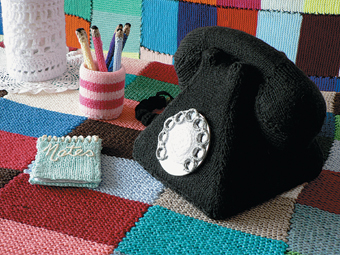
The Knitting Room
photo Robyn Carney
The Knitting Room
Agapanthus, geranium and lavender bushes line the white picket fence. Inside the front door is the living room, home to an old dial telephone which sits on a small table with a crocheted tablecloth. A homemade sponge cake is ready for visitors and a turntable (His Masters Voice style) sits poised to play the nearby Elvis record. I could easily be describing my grandmother’s house; but this is The Knitting Room and all of these objects have been knitted, crocheted or woven to make up the exhibition at the Moonah Arts Centre.
The Knitting Room is intriguing for its colourful detail, its historical and cultural value and its surprisingly raw humour. A knitted tyre-swan, iced Vo-Vo’s, Flick bug-spray container, the milk bottles sitting by the door, are all iconic items now disappeared from everyday life. These specific objects of an era now passed, have been created by the over 300 participants in this exhibition whose average age is around 70, with the oldest aged 96. The Knitting Room arouses affectionate memories. The objects are so lovingly made and the room emits this enjoyment.
You enter via the front yard; and from there you are invited to step into the living room, the kitchen, the laundry and then the backyard. The living room is obviously primed for potential visitors, but the kitchen and laundry sit behind-the-scenes for the regular visitor. I feel as if I’m intruding as I observe a knitted woman relaxing in the privacy of the laundry with her feet up, a cigarette close at hand. Adding to this feeling, the rooms are all roped off giving it a distinct museum aura.
Jennie Gorringe, the Arts and Cultural Development Officer for Glenorchy Council, informs me that this exhibition is a collaboration between nursing home residents, community and environmental groups, the CWA, day centres “and artists”, which explains the eclectic mixture of styles, objects, methods of making and materials. I have to question Gorringe’s use of the word ‘artist’ however. Knitting has long been associated with craft, and more specifically with “women’s activity” and consequently, is rarely seen in the context of high art. I am aware of a number of female artists who are trying to subvert this assumption and, observing the skill displayed in The Knitting Room, it’s easy to see why. I believe all the participants in this exhibition should be acknowledged as artists. Labelling the exhibition as a ‘community project’ also somehow undermines the worth of these participants’ efforts. On the technical side, I am greatly in awe of the skill and time that created such a feat. I know from my own disastrous attempts at knitting!
The Centre expects 4000 visitors over the course of the exhibition, and has had a great deal of interstate interest following coverage on ABC TV’s The Collectors and The Arts Show. By the time I arrive at Moonah Arts Centre, the exhibition has been open only half an hour, but 55 people have passed through the doors. This is a true testament to the wide appeal and novelty of this theme, and entirely appropriate for such a moving exhibition.

Christine Anu
courtesy Showtune Production
Christine Anu
Everyone loves a Diva. The ability to wrap a whole audience up in a gaze and have them smiling unconsciously at your beauty and glowing presence is rare and I imagine it’s a quality to which many female performers aspire. Both Lura and Christine Anu summoned up the spirits of the great divas in their performances in the Pacific Crystal Palace with varying degrees of success.
Raised in Portugual, Lura has made her home in Cape Verde—a series of islands off the coast of Senegal. Christine Anu, more familiar to most of the audience, is a Torres Strait Islander whose rendition of “My Island Home” is played on any available, celebratory occasion in Australia. Both women are utterly gorgeous and magnetic—ticks one and two in the list of how to be a diva. With front row seats for Lura (a single name is also a diva trademark), I was transfixed by her face, her amazing crop of fine curls and gorgeous smiling face atop a tiny frame clad in traditional African skirt and top. There was a sense of knowing and control about each of her moves and an effortlessness in her earthy voice. From my seat at the back of the room, Christine Anu also glowed like a mermaid in her shimmering dress. Her oiled, long curls magnificent, her smile wide. From the first moment, she captured our gaze. Going well so far.

Lura
photo Deborah Metsch
Lura
Musically, the journeys that each took the audience on were quite different. Lura’s show was entirely composed of the music of her Cape Verde home which she textured with stories and explanations of particular rhythms. I enjoyed the nonchalance of her predominantly African backing band. With that diva quality kicking in, Lura transformed the feeling in the room from exuberance to melancholy in the flutter of an eyelash. The sadness in her ballads was palpable and she seemed to need a moment at the end of each to recompose, such was her engagement with the song.
Anu’s program was more mixed. In the first half she worked alternatively with originals and blues standards. Songs were introduced with delightful stories about her Islander upbringing and her identification with the feeling and form of the blues. I particularly liked the way she sang the negro spiritual Wade in the Water after telling a story about making her way to her village church via the beach, then went on to a beautiful song about her grandmother’s hands. Taking a lengthy break which was covered by her band, Anu re-emerged wearing an enormous, red, afro wig and proceeded to complete her program with a solid block of blues standards. She lost me at this point and I found myself withdrawing from the show, crossing my arms and sitting back in my chair. Why? She can crank out immaculate versions of these tunes – Natural Woman, Georgia on My Mind, Fever – and has the most beautiful hair, so why the wig? Deduct a tick for distancing.
I guess the final tick on the diva checklist is crowd response and for this Lura and Anu came up trumps. Lura’s audience responded to her sexiness, her rhythms, her engagement. When she commanded the entire group to “get up” to dance at the end of the show, there were no arguments. Christine Anu’s audience were feverish. I heard a woman behind me say “Did she touch you?” after Anu had just done a lap of the room handing out touches like an evangelist. There was much hooting and stamping of feet to bring each of the singers back for an encore.
There is no doubt that each of these singers is a diva. Lura and Anu matched each other on beauty and magnetism and the ability to fill the room with their voices. But Lura won the diva contest for me with her emotional connection with the music. Her contagious smile and long pauses, eyes closed, at the end of particular songs were compelling. Diva or not, I was left wondering about Christine Anu. I feel that she lost her footing when she took on a wigged persona. I wished that she’d been comfortable enough to make the blues standards her own and know that she could do so without somebody else’s hair.
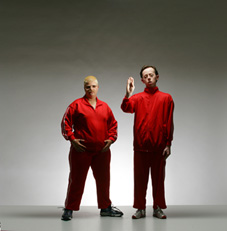
Sonia Teuben, Simon Laherty, Small Metal Objects
photo Jeff Busby
Sonia Teuben, Simon Laherty, Small Metal Objects
There is something very intimate about listening to music or voice through headphones. It is as though the sound hovers in the middle of your head, making itself comfortable in your own thoughts. A haunting musical score and a personal, heartfelt conversation fill this place in the opening scenes of Small Metal Objects.
Staged in Salamanca Square, the construction of a story through sound provides the structure for the show. The audience is housed in raked seating at the end of the square. Each wears a set of headphones for the duration of the show. The remainder of the Square, the city and the mountain beyond form our stage. With an apparently empty stage in front of us, to any passerby we are quite the spectacle.
In the opening minutes we are all expectant. The music begins and with that, we search our stage for any person or sign that could be part of the show. A conversation opens in our headsets with, “I cooked a roast last night.” This is chat between two male friends that mixes ordinary observations with personal thoughts on life and love, “You know what you should do? Get a pet. A pet brings out the love in people.” The voices are slow and stilted. These are two men for whom speaking takes some labour and thought, but the content of the conversation is common place–loneliness, love, fear–“Are you scared of dying?” Garry and Steve seem close, they talk openly about their affection for each other.
It takes over five minutes until the two men are revealed in the square. I become aware of the sound of falling water in my headphones and realise that it is in sync with the fountain in the square, allowing me to locate the men about 60 metres away from the audience. They wear wireless mikes so that their talk reaches us in real time. The conversation continues as they walk toward the audience and we see that each of these men might be labelled as having a disability. It is at this point that the plot speeds up. Without wanting to give away too much of the story that ensues, Steve and Garry become engaged in an apparent drug deal involving two others who emerge from cafes and restaurants within the Square. Alan and Caroline are a high flying lawyer and change management consultant. The deal falls apart when Steve has a crisis: “I want people to see me, I want to be a full human being” and the couple are unable to get the two dealers to cooperate.
I have to admit to finding the set up for the show compelling but confusing at first and I found it difficult to get past the fact that the square is almost empty at our show’s timeslot – there is something lost in the absence of innocent bystanders as I imagine that their reaction to the play would range from complete ambivalence to avid curiosity. A crowd would have also given the players an environment within which to hide more successfully. It is only in the hours that follow the show, in considering and reconsidering the content, that I realise the greatness of Small Metal Objects.
Certain people within society, particularly the aged and disabled, are often the “unseen” to quote from the show’s program notes. I understand now why Steve’s crisis abates after the bungled deal: “I feel better now.” In the context of the deal, he is not only seen but in control. The high-powered pair, who are accustomed to getting anything they want, going anywhere they please, are rendered helpless. Their money and influence mean nothing and they are forced to operate within Steve’s sense of time. And what a perfect cover if Steve and Garry are actually dealers—would you suspect them?
This is a slow-burn show that left me puzzled at first, and worked its magic afterwards. Small Metal Objects found its way inside my head just like the music in the headphones.

Sonia Teuben, Simon Laherty, Small Metal Objects
photo Jeff Busby
Sonia Teuben, Simon Laherty, Small Metal Objects
I am sitting on tiered seating at one end of Salamanca Square, headphones on, exposed to the wind, the rain and the gaze of passers-by. I am a spectacle In this unique way Small Metal Objects challenges notions of community and judgement in society.
This public space is converted into a stage, and the public are the performers. A conversation between two men is heard through the earphones, punctuated by electronic music, while the audience looks out at an almost empty square searching for the source of the voices. I spot the pair as they pass the bakery; the square is so empty that it’s not hard. They wander towards us, while people walk past and stare at both the performers and us.
The characters, Gary and Steve, both appear to have a disability, made obvious to the public by their physical appearance; and so the stares they receive have a different focus to ours. We have voluntarily placed ourselves in this position, and we can slip out of it after the show when we remove the headphones. I must admit, this is of particular interest to me, because I have worked in the disability services field, and have regularly witnessed quite negative reactions from the public towards people with physical and developmental disabilities. This theme makes Small Metal Objects personally compelling, even more than the dialogue unfolding.
It begins with a conversation about marriage, sexual orientation and the death of Steve’s cat. The language is slow and simple, caring, patient and understanding. Then Gary takes a phone call from a nervous sounding man, Alan, who enters the square, carrying an envelope of cash and talk of a ‘deal’. A ‘business partner’ of Alan’s, a corporate psychologist, is called to the scene when Steve refuses to cooperate in the deal, and she takes over from Alan using different methods of persuasion. Steve needs time, Gary explains to the anxious, pacing Alan, while the music becomes deeper, percussive and suspenseful, matching the tension felt by Alan and his partner. What follows is a sickening display of misunderstanding and disrespect.
However, there is an element of humour in the production, a welcome addition to a grave subject. The introduction of the ‘corporate psychologist’ for instance, where a jargon filled job description designed to impress the listener, fails on the uninterested Gary who obviously holds different values. Later, Steve turns to Gary and says of Alan: “I know he’s famous and all but he just looks like an ordinary guy”.
I did wonder what the production would be like if the square was filled with people. Due to the cold weather and time of the day, the space was almost completely empty, whereas the production is designed for a crowded public space. The actors utilised the space well, traversing the entire square; and I can imagine that my response would be very different if the figures were blending with the public and often blocked from view. In saying that however, the empty square did work as a positive in some instances, such as when Alan was first looking for Gary. Despite standing near him, Alan walked away approaching the few other people in the area, before finally returning to Gary, an emphatic last resort.
The values manifest in Gary and Steve’s characters and their relationship are beautifully observed and played out in the production, in distinct opposition to Alan and his partner. These are accentuated by the body language, contributing in particular to the key interactions between the characters. I have never seen such an original and entertaining attempt to challenge social attitudes that discriminate against people with disabilities.
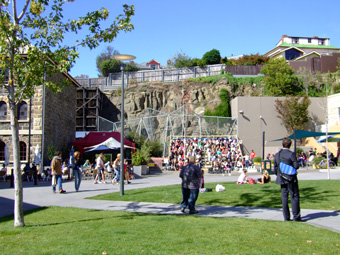
Small Metal Objects
photo Bec Tudor
Small Metal Objects
Scouring the scattered groups passing between the restaurants and bars in workday twilight I am trying to match the intimate conversation coming through my headphones to people in the square. Two males speak frankly about love, relationships and loyalty. The lines are delivered slowly and deliberately. Steve is depressed, he wants a girlfriend, he’s also wondering if he is gay. From my vantage point on the raked seating tucked into the side of Salamanca Square I focus briefly on a group of young men smoking. The other guy, Gary, is understanding, “You’ll work it out mate…I just want to see you happy.”
Disparate piano notes and a deep repeated reverberation form an ambient, almost cinematic, soundtrack supporting this dialogue. I start thinking that perhaps I will not meet these characters. Couldn’t this almost be anyone’s conversation? I watch passers-by watching me. I am completely comfortable in my voyeurism, elevated and aurally insulated. Shit weather is rolling down off Mount Wellington, it’s cold and windy and the square is emptying out. Behind the voices, the recognisable sound of falling water suddenly emerges and I immediately look to the fountain. The protagonists are easy to identify—not because they are miked up actors in a public space—but because they look and sound like they might be people with a disability.
An outline of the story is insufficient to explain this performance. However, as it develops it involves a young property developer named Alan who is desperate to buy $3000 worth of drugs from Gary and Steve. Like the businessman, I am unsure whether what ensues is merely the result of a miscommunication, or if the dealers have a very unorthodox way of doing business. The “goods” are never named and neither Steve nor Gary ever directly confirms they have them. The correct money is handed over but the trio never walk to the locker to collect because, as Gary explains, “Steve won’t leave that spot and I won’t leave him alone.” A distressed Steve has decided it’s time to be seen—he wants other people to value him as a full human being. The deal is off.
In desperation Alan calls in colleague Caroline, a corporate psychologist in the business of ‘change management.’ She tries all of her manipulative, condescending tactics and eventually loses her last thread of integrity when she tries, unsuccessfully, to lure him with the promise of sucking his dick. The executive pair leave in anger, chasing an alternative score. Steve and Gary are nonplussed. In fact, Steve feels better now.
The performance finishes and I am utterly bewildered. It’s like I never quite got to connect the dots, and yet I don’t feel it entirely went over my head either. I enjoyed the show, so why do I feel I don’t get it? And what were the ‘small metal objects’?
I’m thinking the title could refer to the money exchanged (though that was in paper notes) and Steve and Gary’s comment early on, “Everything has a fucking value!” Having the right change doesn’t necessarily get you what you want. Being loaded doesn’t make you happy. Being ‘less fortunate’ doesn’t always mean you’re missing out. Money, after all, is just small metal objects.
In a funny way the small metal objects could refer to the radio microphones. While these are hidden on Gary and Steve, Alan and Caroline wear highly visible headsets. This technology gives the high-powered professionals an aura of authority, like they’re privy to more information than the others. The radio microphones connect the audience to the action in a manner of surveillance, which in this age of terror, operates through the identification of difference.
It’s fair to say that the general public pay no attention to those performing out there in public space. Not even when Caroline yells insults at Steve. Not even when she’s pulling his arm and Steve cries out “I don’t want to go.” Suddenly this scene takes on the sickening likeness of a child-snatching in a crowded shopping centre, where later everyone wonders how no-one saw or did anything. How would you react if you saw a drug deal underway in public? Or an aggressive argument between a woman and man? Social awkwardness often leads us to look away thinking we’re not implicated, thinking, I’m sure they’re alright. How do you behave when simply you encounter someone with a disability?
Dependency is the recurring theme of this performance. Gary provides emotional support for Steve, who supports Gary when it comes to ‘doing business.’ Between those two there is a short discussion about pets. Caroline accuses Alan of displaying needy behaviour when he calls her for help, yet they are both desperate for the drugs. And underlying all this is the idea that people with disability are people with ‘special needs.’ Implied in this euphemistic phrase is the belief that these people depend on others to live an ordinary life. But there is nothing Alan or Caroline have that Gary or Steve really need or want, and they refuse to be used as mere conduits for a transaction.
There were aspects of Small Metal Objects I simply didn’t understand—Steve and Gary’s ‘business’ discussions for example. And I wonder if something was lost because the square was so quiet that day. Or maybe because the culture of Salamanca precinct is so tourist-driven that a little rain completely drains it of atmosphere. I imagine the experience would have been very different in the bustling civic spaces of Sydney’s Circular Quay or Melbourne’s Federation Square. And perhaps even the thoroughfare of Hobart’s greasy Elizabeth Street Mall (where, incidentally, I regularly witness public fights and intoxicated people) could have been a more fruitful setting. The enduring dynamic I am left contemplating is the friendship between Steve and Gary. Throughout all the assumptions, value judgements, transactions, pressures and attempted manipulation these two are like rocks in a stream. They have integrity, they stand by one another, they have love. They may also have had $3000 worth of drugs, but I’m still not sure about that.
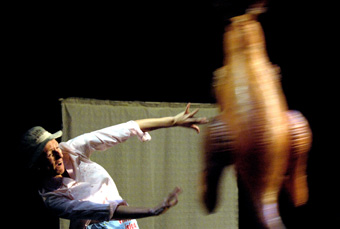
Cheryl Wheatley, Queen of the Snakepit
photo Michael Rayner
Cheryl Wheatley, Queen of the Snakepit
Distracted for a moment in Cheryl Wheatley’s Queen of the Snakepit, I found myself mentally revisiting that seminal 70s pedagogical text for actors by Robert L Benedetti entitled Seeming, being and becoming—as you do.
Wheatley comes on strong in her persona as Lois, our guide on a virtual tour to Flinders Island in the northeast corner of Tasmania. Lean and rangy, clad in skirt and blouse, knee-high stockings and plimsolls Lois is an instantly engaging, if brash and bawdy host, shouting some of us down the front a beer (or a shandy), which she whips from her well worn Esky. Later, from this bottomless pit, she’ll also extract a slide projector and a couple of inflatable kangaroos. Like any good guide Lois introduces us to the outstanding features of the island, including its incessant wind. To do this, she lugs an industrial strength wind machine from the wings. When, in the process, she inadvertently knocks the hat from the head of the Mayor of Tasmania (who’s apparently rarely seen without one), Wheatley handles it all with bravura and the audience (Mayor included) respond with even more good humour. Playing the affable guide seems an easy transformation for Cheryl Wheatley who was born and bred on Flinders Island and has a deep love for the place (she identifies its location by referring to her own breast) and the earthy characters who populate it. As in all good performance, it’s often difficult to untangle the persona from the performer herself.
The other aspect of the work demands that, before our eyes, the performer “becomes” a series of women—the ones who stay on the island while the men go to sea and hence, she believes, share a unique understanding of the place. Most are variations on Wheatley’s relatives, among them, Queenie, based on her grandmother, an earthy old lady who holds court in the “Snakepit”, the ladies’ lounge at the back of the pub. Wheatley’s work with mentor, John Bolton, presumably focused on developing each of her personae in this work in situ. Somehow, though, as Wheatley steps in and out of these imagined bodies, she loses her performative footing. She adopts the physique, the vocal tics, a nicely poetic turn of phrase, but now appears actorly, tongue-tied, less assured in her connection with the audience.
Finegan Kruckemeyer has the writer credit on this show but clearly its construction has involved a number of hands including the performer herself as co-devisor. Sound artist, Jethro Woodward’s work provides an important atmospheric layer. There’s also a rudimentary show of slides that fits the homey feel of the show. At another distracted moment, I imagined Lois as one of those well-equipped guides with a video camera that would allow us some quality images of the Island. Principally, though, I’d say this promising work has a way to go to achieve the fluidity of form suggested by the material. Some sharper writing is needed for the island “characters” and a more comfortable performative bridge to take performer and audience safely from the friendly engagement of the guide we meet at the beginning of Queen of the Snakepit to the deeper understanding embedded in the female spirit of place that it seems Wheatley would like us to souvenir from her tour.
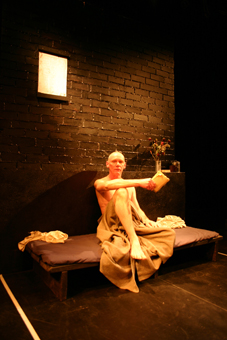
Robert Jarman, The Spectre of the Rose
photo Carolyn Whamond
Robert Jarman, The Spectre of the Rose
It’s good to be surprised. It keeps you on your toes. There’s a moment in The Spectre Of The Rose where Robert Jarman, as Jean Genet, takes a razor to his own wrist. Ugly and abject, this was also a moment of revelation: despite being the third time this work has been mounted in Hobart the text itself is still being interrogated. Each time, some new, darker meaning is dragged into the light.
As Genet’s small bright wound was revealed, the whole performance shuddered closer: I understood something. This show is about Genet in his familiar roles—thief, writer, homosexual—but it’s more: an attempt to get underneath the Genet created by the text to the Genet writing, living the text in his cell, where this play’s action occurs.
The key moment arises as Genet indulges himself in a dark sexual fantasy: rough street sex with a sailor he then imagines murdering for the sheer thrill of it. It’s a fantasy drawing on Genet’s adolescent idolising of famous murderers. In Jarman’s previous versions we witnessed Genet somehow triumphant in his cell indulging like a dark god in extremes of sex and death. Here was the same empowered Genet, but with nowhere to direct the raging energy he has built up, but at himself. There is no sailor. He is alone. He is cutting himself.
That’s all he can do. Is this release?
There is further to go and worse to see. Jarman’s Genet has already told us, epigrammatically, that the only way to escape horror is to bury yourself in it, and that’s the way this narrative goes, into a horror starker than Genet had ever imagined. He is alone, naked in his cell, howling to the stone walls: “Kill me! Burn me!”, a cry competing with a terrible throbbing on the piercing soundtrack.
Genet’s brutish epigram is however realised: somewhere in this awe-full moment is the kind of transcendence Artaud sought in his Theatre Of Cruelty. The performer is naked and open, totally exposed, in a moment of symmetry in his engagement with the text. Nudity is a hell of a gambit in theatre, and may miss the mark of genuine transgression by being simply gratuitous, but here I felt it was successful, adding meaning rather than shock. We were looking at a real Genet, failed by his own fantasy: he cannot kill. He is not one with the murderers he idolises. He’s a thief. All he can do is wound himself, the cut revealing far more than blood, the text exposing an angry human, his articulacy warped by imprisonment, a man mired in consuming erotic fantasies, which despite their ultimate failings are still all he has to sustain himself. It’s a deadlock: there is nowhere for him to go, no God to judge him and give him release. He crawls back into the bed where we first saw him. The performance ended, but there was, and still is, a ringing in my ears.
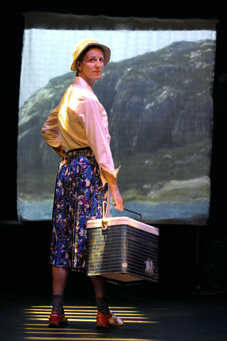
Cheryl Wheatley, Queen of the Snakepit
photo Michael Rayner
Cheryl Wheatley, Queen of the Snakepit
Lois stands on a chair holding two lit torches as headlights. We’re passengers on her ute tour of Flinders Island and everyone in the audience has been made to put on their seatbelts. She calls the potholes in the dirt road ‘Dolly bumps’ because, while Lois loves Dolly Parton, at times like these you’re glad you don’t have her attributes. On “go” two audience members hurl inflated kangaroos at Lois’s head. Chaos briefly ensues. With manic swerving and cursing she avoids a crash and the guided tour through family history and mythology of place continues.
All the props in this performance emerge from Lois’s Esky, and many of them end up in a strange shrine-like arrangement carefully constructed over the duration of the show. Containing fragments from the stories told, such as Naked Lady flowers, abalone shells, paper nautilus shells, the pieces of a ripped-up crayfishing licence and a windswept tree branch, this assemblage is like a tribute to Flinders Island. Throughout we’re shown a teatowel map and hazy landscape images, but it is this collection that makes Flinders visible for the audience.
In Flinders folklore the paper nautilus shell washes up every seven years. This periodic appearance is symbolic of the islander way of life, characterised by a gradual passing of time that is measured on the ancient scale of the landscape itself. The return of the shell also mirrors the journey of the island’s youth who leave seeking adventure and return home (the place, as Lois found, where your feet grow roots) years later. Coming to shore from the ocean, the shell also links the domains of the men and women folk. We learn that while the fishermen are free of the island when they are at sea, the women are relentlessly land-bound.
Queen of the Snakepit is the story of female life on Flinders told through four characters from the one family. In addition to Lois there’s her cantankerous mother Queenie who single-handedly built a jetty of stones for her fishermen husband and sons to come home to, but now spends her days alone. There’s eccentric aunt Myrtle who, when her complaints to Parks and Wildlife back in the early 1990s were ignored, took the feral cat problem into her own hands. And there’s the memory of young Lily staring out the window asking questions and making observations about this place and its people. She at first seems to be Queenie’s dead daughter, but is later revealed to be Lois herself.
This performance is devised and performed by Cheryl Wheatley. She undergoes impressive physical transformations as she morphs between four women of different generations to create a montage of incidents and memories across time and space. Moments of humour and intimacy created by each character propel the performance. Queenie’s debate with herself about whether or not the old pine tree needs its middle cut out was for me a very tender insight into a life of hardship and isolation. We learn from the dedication at the end that the character of Queenie is actually based on Cheryl’s mother, who passed away only weeks before this show opened.
In contrast to these engaging characters our guide and narrator Lois seems a conglomeration of loud ocker stereotypes—from her op-shop ensemble to her clipped language, hackneyed expressions and tit jokes. Sure, Lois is meant to be a woman of strong personality, the tough-as-guts country type who’s lived most her life in a small male-dominated community. I know this kind of sheila, I’ve got one or two in my own family, but I find Lois an ugly caricature. I see none of the knowingness, the disarming charm or dangerously sharp wit that makes natural yarn spinners of the Australian breed so charismatic. Given Cheryl is a fourth generation Flinders Islander I wonder why she felt the need to invent the ‘larger than life’ Lois.
It is only as Lois that Wheatley initiates audience interaction, and her manner is rather like playground bullying. She plays favourites with some individuals with whom she holds inaudible, rather lengthy, one-on-one conversations mid-performance. In other moments she intentionally invades personal space, helping herself to our drinks, blasting us with a wind machine and spraying us with water. I think I experienced a personality clash with Lois. I suspect, at its root, this may reflect a discomfort I feel with much such theatre. But that aside, I simply didn’t find this “witty and wise” character insightful or funny.
There is beauty, richness, idiosyncrasy and universality in the stories of Queen of the Snakepit. The family connections between characters give this account of place its form and sense of authenticity. Unfortunately however, the crude rendering of the central character meant that intimate and engaging moments were scattered through an often tedious and frustrating show. Curiously, I like the fact that after this ‘tour’ I still have very little sense of what Flinders Island would be like to visit.
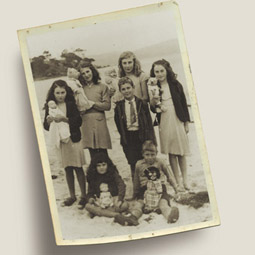
Maria Island school children, c1930, Anne Christie collection
How many islands are there off the coast of Tasmania? Do you know how many people live on them? Anything about their chequered histories? What makes these places special? Most importantly, what does it feel like to be an islander? I’m a Tassie girl through and through and I don’t even have half the answers. With a quest to right this wrong Maria Island of Dreams and Queen of the Snakepit take audiences on a guided tour of two Tasmanian islands.
Along with its Indigenous occupants, Maria Island has hosted inhabitants from a parade of countries throughout its extraordinary history including Holland, France, England, Italy and New Zealand. Devised to weave music, poetry, video projection and spoken word, the show tells the story of Maria Island through the recollections of Vega Bernacchi, the daughter of an Italian entrepreneur, and a host of other characters. Accompaniment is by local group Silkweed, on violin, accordion, keyboards, cello, percussion and voice, and whose members are woven into the story telling. Apart from a dancing couple who appear towards the end of the show, the musicians and narrators all stay in place, concert-style for the duration.
For Vega Bernacchi (Sarah Cooper), Maria Island was her first playground. She recalls her delight with the sound of the Indigenous name of the island and childhood re-enactments of the penal settlement era. She is nostalgic for the time when her parents farmed wine and olives and her own life as an adult on the island. Against a projected backdrop of historic images, family photographs, paintings and present day landscape shots, we hear snatches of letters and reports from French explorers, English convicts and their captors, Moari martyrs, an Irish political prisoner and Diego Bernacchi whose dreams for Maria seem to be the inspiration for the show’s name. The male characters are played by Les Winspear. Silkweed build the atmosphere with delicate tunes and folk songs that flesh out the emotions of the events. There is a sense of completeness to the story—we see the life of Maria Island go from uninhabited to agricultural and semi-industrial and then back to nature—as a reserve. Maria Island of Dreams is comfortable, polite—a multimedia recital.

Cheryl Wheatley, Queen of the Snakepit
photo Michael Rayner
Cheryl Wheatley, Queen of the Snakepit
By comparison, Queen of the Snakepit is brash and loud. We are a captive audience. Lois (Cheryl Wheatley) from Flinders Island takes us on a tour of island landmarks and characters. She is a bundle of love and hard luck with her white cricket hat, high waisted nylon skirt, saggy shirt and slip-on sandshoes. Lois’s Esky is her magic pudding of props—everything emerges from the ubiquitous white lidded box throughout the show. A tea towel tucked into her waistband is the map for the tour and a suspended sheet is her projection screen. With the audience seated cabaret style, Lois weaves between the tables alternatively delighting and harassing us with her demands for attention and participation. While this is confronting for some, there is a disarming sweetness and warmth to Lois’s engagement: “yeah… that’s all you need to do really, say G’day back, then you might get to know someone that you never imagined knowing.”
For the hour of the performance, Lois is all of the women of Flinders as they watch their men come and go from the sea. She morphs into Queenie (the Queen of play’s title), her aunt Myrtle, and herself as a child. Queenie and Myrtle are tough, wise and very rough around the edges. Just like the tides, these women represent the ebb and flow of island life. While Queenie has spent her adulthood giving birth to islanders (eleven children in all) and seeing her men off to sea, Myrtle bears witness at the other end of life, making wreaths for the dead from “the old flowers, that most people call weeds” along with slaughtering as many feral cats as she can get her hands on. Wheatley’s characterisations of these women are both humorous and poignant. We laugh at Queenie screaming for her beer from the Snakepit (a nickname for the Ladies’ Lounge at the Whitemark Hotel), while also registering her grief: “You should never have to bury your children. They should bury you.” Like breaks between chapters, Lois builds a shrine throughout the show that is composed of important objects or island symbols. There are the trees that “grow sideways like the people”, the nautilus shells that keep time, and the ever present snakes that seem to represent fear, wisdom and longevity.
Maria Island of Dreams and Queen of the Snakepit use varying degrees of characterisation to provide insights into the histories and cultures of the islands. Cooper’s playing of Vega Bernacchi is critical to shifting Maria Island of Dreams away from being simply a historic summary. Vega’s obvious affection for the various lives of the island, including her own, is clearly communicated, yet there is still a sense of distance with this recital-style telling that leaves the audience back on the mainland. I can now answer a whole series of questions about Maria and can visualise its topography, but I don’t feel as though I’ve visited. Lois’ tour however does take us to Flinders Islands: there is an uncomfortable sense that we are stuck in the Whitemark Hotel with her and Queenie. Unfortunately the dramatic structure of the play is too loose, some characters are under-developed and the components of audience participation, including getting two people to blow up kangaroos, seem a distraction from the core idea. I come away with an abstracted image of Flinders Island as a place, but feel as though I’ve imbibed some of the longings, sadnesses and frustrations of the Islanders.
I’m a little uncertain about this documentary style of performance because it hangs on the edge of being touristic. That aside, perhaps the shows need to swap directors for a day making Maria Island of Dreams more engaging and less polite and Queen of the Snakepit more rigorously structured, and with more background information, so that their audiences could live a fuller hour of life on these islands.
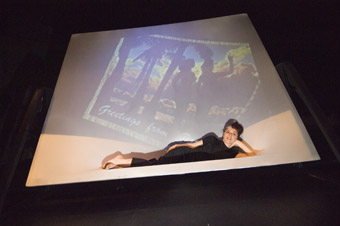
Linda Mancini, Bikini
“In July 1946 the United States dropped a series of atomic bombs over a small ring of coral islands…called Bikini Atoll. That same week French designers…launched a very tiny, very risqué line of swimwear on the world…[named the] ‘Bikini’ on the reasoning that the burst of excitement it would cause would be like the atomic bomb.”
When I read this in the Ten Days on the Island program I assumed it was a joke—a fictional premise for an entertaining performance. The diabolical truth, that the bikini was actually named after the Bikini Atoll, was confirmed by a friend; and drastically changed my expectations for the production (also named) Bikini. Linda Mancini’s production is politically satirical, a one woman, multiple character show connecting Bikini and the bikini, and ridiculing the US army, an ignorant public and the fashion industry along the way.
We are first introduced to the embarrassed Chrissie, a 14-year-old girl trying to change her image in order to enter a bikini contest. “My mother always told me ‘you’re too fat to wear a bikini’”, she announces before taking us to visit the beauty salon to share the experience of her first horrific bikini wax. Another woman with a strong New Yorker accent, playing charades, guesses “the bombings of Bikini a-toll booth”…“What the hell is that Louis?” she yells angrily at her invisible partner, shockingly ignorant of the tragedy. Later in the performance, this woman's sister-in-law embraces a one-off opportunity to travel to the still radioactive ring of Islands, a caricature of the American public and their tendency to holiday almost anywhere.
Rita Marshall is Mancini’s third character transformation: a nationalistic ex-US army officer who served at Bikini Atoll during the bombings. She describes her pride in serving her country, and seems completely blind to the environmental devastation, the deaths following animal testing, the permanent relocation of the indigenous peoples of Bikini, as well as the permanent health effects on the army personnel who were involved. Her husband passed away at a young age, Rita explains, glossing over the fact that the death was related to nuclear exposure. Ironically, Rita adds that her own sight has been affected by cancer.
In a momentary dimming of lights, Mancini promptly changes into a fashion show presenter promoting “Fashion with a conscience.” She decides that ‘the network’ should hold a bikini competition on Bikini Atoll. “Is it safe? Can someone find that out for me?”
Mancini is swift in her character changes and has made each of her characters distinctive. Rita sits straight in her chair, eyes squinting and talking in a slow Texas drawl; Chrissie stands embarrassed twirling her top through her fingers, and has a juvenile style of speech; the fashion presenter stands prepared to dazzle, directing technical assistants to find better images which flash on the screen behind her; and the New Yorker talks loudly into a telephone, at her new beauty parlour Coco Ch’nails, complaining constantly about her sister-in-law.
Bikini is intriguing for its lack of props and simple design – one chair and a screen. The screen also doubles as a table, a door, a beach and finally a bed; and is stretched with an impressively hardy lycra-type fabric, which easily holds Mancini’s weight.
The serious truth behind the Bikini Atoll bombings is at times at odds with Mancini’s comedy. This was more than satire. When shown the photos of animal testing, tears ran down my face. I stopped following the story quite as intently.
Bikini was was clever in its interweaving of characters, often small but poignant observations, and its political satire – a very slick production that left me both enlightened but entertained. Mancini’s Bikini reminds us about a largely forgotten historical event, warning us not to repeat the same mistake.
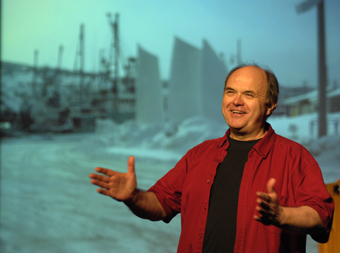
Andy Jones, To the Wall
photo Michael Rayner
Andy Jones, To the Wall
It’s immediately and alarmingly clear that you’re locked in a room with an eccentric. You’re a captive audience. You pray it’s a non-participatory one. Newfoundlander Andy Jones comes on, an engagingly pushy mix of lecturer, spruiker and preacher, flogging a thesis that will explain why humans are so bad to each other, and what we and God, should he exist, can do about it. The extrapolation of the thesis, he advises us, will take the whole performance. In the meantime he kicks off with something terribly contemporary—anxiety about anxiety, specifically the human wiring that triggers: “future possible, possibly horrible” (which he titles fitposs, economising from a French-Canadian rendering). We’re all very attentive and the brisk texturing of references French, Irish and Newfoundland layers the thesis-making with something very particularly cultural and possibly personal—as in Jones’ droll description of his intensely exclusive Roman church upbringing as “Hasidic Catholic.”
Most of the time fitposs (“a déjà vu of the future”) prepares us for the worst, but September 11, 2001 shocked the atheist Jones into prayer—what else could you do, he asks. This plunges him into a big question—are we God’s experimental failure (God wanted equals, got nasty supplicants and is profoundly lonely, and therefore absent)? He offers some big solutions—let’s invite God to a public meeting, in this theatre, tonight, and propose some genetic tweaking. Without fitposs we might be a nicer species (Jones rattles off a history of the demise of earlier humans not fitted with fitposs—the first of our kind were, of course, Adam and Eve). While modifying our anxiety generator might seem a reasonable idea, Jones is not reasonable in any ordinary sense, suggesting that we have anxiety thermostats visibly implanted over our nipples (slide of Uma Thurman at an Academy Awards thus technically adorned). This will not only make us more aware of each other’s emotional fluctuations but generate some new language: “Go fluctuate yourself!” Wilder evolutionary engineerings are suggested later in the show, but in the meantime there’s much else to rapidly absorb and to reflect on: what would be the saddest story you could tell a rabbit such that its tears would turn to ice and lock it to the ground (and provide you with dinner)?
This is discursive theatre, Jones playing out a persona doubtless rooted in the real man and stylistically reminiscent of the American Spalding Gray, if without the incantatory poetry or darker personal musings, and the UK’s Ken Campbell (Jones was a performer for a period with the Ken Campbell Roadshow). Like Campbell, Jones is in love with the big picture, generating wildly improbable theses that nonetheless tell us much about what worries us and the kinds of not always silly fuzzy logic we apply to such mysteries. Again like Campbell, there’s a mix of real if distorted science and wacko cosmology. Some episodes seem simply off the air, smutty, over elaborate but usually arrive at a kind of meaningfulness, as does the seductive rhetorical illogic of a good sermon (which he illustrates at one stage). Jones introduces us to the Newfoundland beef bucket (used to tenderise tough brisket in salt) deployed in an experiment with his three nubile assistants, seen on screen. They fling sand from such a bucket millions of times, looking to form by chance the perfect shape of Newfoundland and Labrador and they get close. But of course God created randomness. What can you do?
That Newfoundlanders would indulge in such flights of scientific fancy and many other bizarre activities, Jones attributes to the N-factor—a Newfoundland facility for doing things in very odd, lateral and sometimes surprisingly successful ways. This takes us into the country’s history, back to the 18th century, and the Jones’ family’s connection with it, climaxing in the story of his aunt Mary, a Newfoundland beauty who eloped with a protestant English diplomat who was then posted to Berlin in 1939. There it was rumoured Mary, now with an imperious upperclass British accent, snubbed Hitler, so mortifying him that he gave up on invading Great Britain. That’s lateral. The story includes delightful photographs (by Louise Abbott) of a family wedding on a windy Newfoundland day, bridesmaids tottering about the uneven landscape. “No one seems to notice they’re living on a rock!” quips Jones.
If Ken Campbell seems to teeter on the edge of madness in his wilder flights, Jones is on safer ground, for example diverting any extreme nuttiness into the portrayal of a Catholic priest, with Jones asking us stamp our feet when the clergyman has crossed the line into insanity. We’re stamping pretty quickly, but Jones signals that worse is to come.
Like Campbell and Gray, Jones is a deft weaver of tales and ideas, leaving many threads hanging and then ravelling them with bravura sleights of hand. But there are still always surprises to come: “You’re wondering what this show is all about? … Mating!” The cosmological weft is suddenly evolutionary (an earlier thread now picked up) and we’re warped into an hilarious fantasy of genetic tweaking providing the inadequate male with the voice of JFK and bigger buttocks.
There’s plenty to take away with you from To the Wall. Just how many human problems are generated by ‘fitposs’ and what would we be like without it? Why does a confirmed atheist turn to God in moments of extreme crisis? Jones, garbed in a plethora of priestly vestments from different cultures, invites God to join us. He doesn’t turn up, but Jones trips, falls to the stage, and with good Catholic logic, suspects He has been silently present. What are the odds? Other questions linger. How can Catholicism continue to be a creative force when such a punishing one? Above all, is Jones’ account of Newfoundland quirkiness (the N-factor), a condition compounded by Catholicism, true just of his home culture, or is it recognisable, in other ways, in Tasmania or Australia—whose people are so often inclined to insularity, especially now?
Occasional sillinesses aside, To the Wall is amusing and sometimes bracing, performed with affable ease and a self-mockery which fellow islanders from all over will recognise. Best of all, Jones takes the edge off our own troubling fitposs for a while.
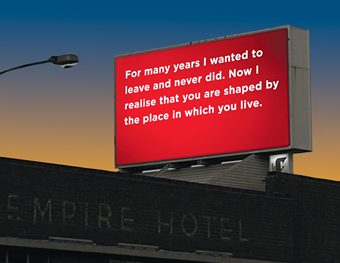
the write/here project
photo Justy Phillips, James Newitt
the write/here project
I’m walking through my city and I discover that something fundamental has changed. The jangle of multi coloured advertisements, with all of their enticements, have been replaced by personal messages, thoughts and musings. I stop and wonder at the text that I see. I find myself agreeing with “Sometimes you make your own traps” and asking myself what is referred to in “Could be magnificent.” This is the urban experience that Justy Phillips imagined when developing an idea for a short film some years ago.
What evolved from the original idea is a massive public artwork developed in collaboration with fellow artist James Newitt, transforming Hobart for just two weeks.
The write/here project strips 27 bill board spaces around Hobart and re-skins them with pieces of text shown in a white, sans serif font on a lush red background. The text originates from 1000 responses to workshops, exhibitions and individual interviews with residents of Hobart. People were asked a range of questions about the place they live in, including “What does Hobart mean to you?”, “Do you have any regrets?”, and “What are your hopes for the future?” The artists selected the final texts to provide a range of responses that retained enough ambiguity to allow viewers to establish their own interpretations.
While there is only spelling, syncopation and choice of phrase to define their voices, the text is seeded with clues that reveal the contributors as diverse in age, experience and country of origin. One board evokes the sadness of old age, “So many of my friends are dead now”, while another suggests the voice of a prisoner or care home resident: “It’s my own space but sometimes I feel I’m trapped in a cage. 6.30 is too early for goodnight.”
With the spread of boards around the city the write/here project is seen in a range of contexts that have a bearing on both the interpretation and the effect of the text. A poignant note about a highway death at the head of the Southern Outlet is likely to leave motorists pondering their own mortality and “Hobart means home, but you can’t spend your whole life at home” is a prompt for those leaving the airport to think about where they have come from or where they return. There seems to be a tendency toward texts that depict Hobart as something other than a peaceful, picturesque tourist destination and some of my friends have reflected that the overall effect is too melancholy to fit with their impression of their city.
Visually, I enjoy the aesthetic of the boards that use the colours of advertising but are stripped of any extraneous information. The clarity of this effect is pleasing, particularly when seen across a collage of windows, roofs and satellite dishes.
The write/here project is clearly a work mediated by the artists, but their touch is light enough to ensure that it is still an expression of a community. There is a lovely sense of relief in seeing meaningful, truthful statements on these boards rather than wildly exaggerated claims or threats that life won’t be complete without a particular product.
Another account by Judith Abell will appear in Landscape Architect Australia, May 2007
the write/here project, curators Justy Phillips, James Newitt; billboards around Hobart, Ten Days on the Island, March 23-April 1
RealTime issue #78 April-May 2007 pg. web
© Judith Abell; for permission to reproduce apply to realtime@realtimearts.net
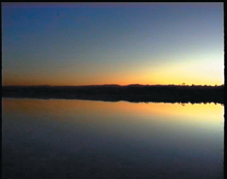
Leigh Hobba
I’m looking at Leigh Hobba’s face from 1982, the corners of his large tortoise shell glasses are rounded in the style of the time. Across five images he smiles or stares impassively. Each fragmented image is composed of squares that are cut, mixed and re-pasted to rebuild his portrait in a way reminiscent of Hockney’s collages of the same time. Combined with its title—Came so quickly from winter in Paris to Summer in Hobart that I could still feel the cold in my body—the series evokes the common sensation of arriving on another side of the world before your body has caught up. This work, mounted near the entry, seems at odds with the others at first, but on reflection, sets the scene for The Space of Presence, a retrospective of the last twenty years of Hobba’s practice.
Leigh Hobba is a prolific artist who has travelled widely, making work since the mid 70s. By the time he graduated from Elder Conservatorium in Adelaide, he was already excited by avant-garde approaches to working with sound, like John Cage’s, challenging methods for making music, embracing chance and using mechanical means to generate compositions. Since then Hobba has built a contemporary art practice utilising sound, video and performance. However for many, The Space of Presence offers the first viewing of the 12 pieces in the show.
As the first set of images suggests, a continuous thread linking all the works is the self, the body and the passing of time. The focus in Hobba’s work is the way he is affected by particular environments, from dense cities to remote Tasmanian wilderness.
This is a song about Hobart and some of the people who live here, is a video and sound work with a single, large screen display. Donning headphones, I listened to Hobba’s monotone recital of diary entries from a time in Paris. He mirrors me in the video, also wearing headphones, his stare unwavering. The monologue is a fast-spoken narration of ordinary events and acute observations, often humorous. Towards the end of the loop Hobba speeds up the recital to the point where the words take on an overlapping song-like rhythm with phrases repeated, broken down, rearranged.
I’ve seen Mycenae glistening over the wine dark sea, is a compelling, sensual installation enclosed in a dark, brick-red space dominated by a large projection of mist softly revealing and concealing a rocky outcrop. As if to emphasise its intermittent absence, a thick black line overlayed on the video provides the outline of the outcrop, even when it cannot be seen. Three small screens placed on the floor around the room show Hobba’s young, sleeping son. Lying on a black background, his pale skin and red curls angelic, the boy is so still his breathing is almost imperceptible. A long, low bench, placed diagonally in the centre of the space is covered with large rocks, each the size of a dinner plate. On three walls, door-sized panels, striped with mirrored perspex are fixed horizontally and vertically to reflect the greys of the mist and movement of visitors. The imperfections in the perspex stripes recreate the facets of the rock face. Having spent some time in the room, I come away with a sensation that is difficult to describe and the exquisite image of the boy fixed in my mind—his tiny breaths are the key here. Somehow.
There is an overwhelming sense in the gallery of time passing and the presence of a man for whom this is a preoccupation. While the works appear to be intimately connected to Hobba’s sense of self, they lack self-consciousness—there is no compulsion to be an artist of a particular time or type—and many pieces are unapologetically obtuse. He is quoted in the catalogue: “For me the act of recording is the act of documentation—a document of experience—in crafting that documentary, one might indeed create good fiction; in creating fiction one might equally create a good documentary.” Like the act of staring at rocks in the mist, I don’t think that we need to necessarily understand this exhibition, we just need to experience, to register its effect in our bodies.
Leigh Hobba, The Space of Presence, curator Craig Judd; Tasmanian Museum and Art Gallery, Hobart, March 16-April 29; Ten Days on the Island, March 23-April 1
RealTime issue #78 April-May 2007 pg. web
© Judith Abell; for permission to reproduce apply to realtime@realtimearts.net
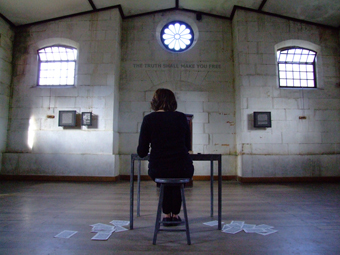
Brigita Ozolins, The Truth Shall Make You Free
photo Bec Tudor
Brigita Ozolins, The Truth Shall Make You Free
Taking my map and setting out to find the Port Arthur Project in this former penal settlement is like embarking on a treasure hunt, my first trial being to cut through throngs of tourists in the information centre and then the milling crowds waiting for guided tours. Finally I break into the open space of the foreshore lawn and my quest to find the Art hiding amongst the History begins.
Peering into the rectangular cutting of an excavation site, roped off in official fashion, I see the puzzling sight of bitumen inset with road disk markers and a drain cover. The accompanying interpretation boards displaying reproduced landscape paintings of the penal colony offer little clarification. It takes a minute and then I realise with amusement that what I’m looking at is a car parking space. Lucy Bleach titles this mock archaeological dig Reserved. It pokes fun at the visitor’s romanticised idea of history as static, and playfully queries what future generations might deem worthy of preservation from the present.
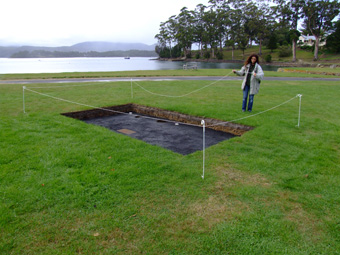
Lucy Bleach, Reserved
photo Bec Tudor
Lucy Bleach, Reserved
A few hundred metres away ten conical forms of about 1.5 metres in height, woven from tea tree and dodder vine and circled with a line of sand, are positioned in a ring. The organic material is dying and drying out; given enough time they will disappear into the earth. The shadows stretching from the work are strikingly figurative and I feel I am not entitled to step into this sacred congregation. Indigenous artists Lola Greeno and Vicki West have collaborated on Premaydena to honour the traditional owners of the Tasman Peninsula, the Oyster Bay people who were forcefully displaced by European settlement. It is a powerful representation of identity interwoven with place and environment. It’s remarkable that Port Arthur does not already have a permanent installation of this power to give due recognition to the earliest chapters of human history in this site.
In the quaint waterside Sentry Box I discover Matt Warren’s sound installation Cantus 35. A single wooden chair invites me to enter the dark cubicle and, once seated I look out to a glorious view of the sparkling sea. Around and behind me harmonic tones toll, swell and diminish, return, overlap and suspend. The soundscape is melancholy, enduring and emotive. My time with this work and this spot is intensely private. When I reluctantly draw myself out of this state of meditation I read that Cantus 35 is a response to the unforgettable sound of gunshots heard in radio newscasts during the Port Arthur massacre of 1996. Comprising 35 tones, this work pays tender tribute to each individual who lost their life. Warren is brave to have tackled this most recent dimension of the site’s tragic history, and he is the sole artist to do so.
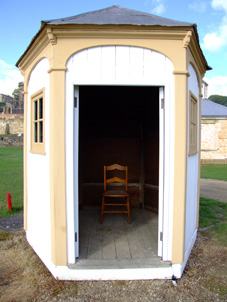
Matt Warren, Cantus 35
photo Bec Tudor
Matt Warren, Cantus 35
I climb the sandstone stairs to the cylindrical guard tower and find Anne MacDonald’s Memory no.5, a photographic installation exploring the passage of time and the inevitability of death. The word ‘memory’ is repeated in grainy black and white and I am confronted by the paradox and futility of trying to salvage something eternal in the face of mortality. Erosion has degraded the carved texts that derive from headstones. I struggle to conceive of the convict thousands who died under abject conditions here. I know that many were buried in unmarked graves on the Isle of the Dead. Each image is mounted in white and framed in apt funerary simplicity. Five works, in vertical arrangement, hang on either side of the pathway that transects the circular space, and on passing out the other side of the tower I am conscious of time sweeping me, slowly but firmly, through space.
I discover Brigita Ozolins seated at a small desk in the oppressive Separate Prison Chapel. Her feet neatly together, the artist at first appears a studious pupil. However, with nibbed pen and bottle of ink, she carefully writes over the pages of a printed book in an action reminiscent of the ‘lines’ naughty children were once given as punishment. When she fills a page she tears it out letting it drift to the floor before beginning the next. Her script repeats the statement she faces on the wall above the pulpit: The Truth Shall Make You Free. Ideas of truth and freedom must have seemed abstract for the incarcerated, especially here, where solitary confinement epitomised disempowerment and voicelessness. This defiant performance is one part of Ozolins’ tribute to inmate Henry Savery (convicted for forgery) believed to be Australia’s first novelist, who died and is buried at Port Arthur. She is writing on the pages of Quintus Servinton, Savery’s autobiographical novel. Writing ‘their truth’ must have provided precious self-affirmation and escapism for those convicts lucky enough to be literate.
Obviously not all visitors appreciate artistic intervention as part of their tourist experience. I see curiosity dissipate in a puff of annoyance for several people when the realisation hits that this is art. Cameras are lowered and retreats hastily made. However, I am impressed that most visitors are willing participants in critical analysis of the heavily mediated experience for which they have paid handsomely. Those who’ve bought Lucia Usmiani’s fold-out photographic mementos of the Port Arthur “red posts”, “pieces of ground”, “seats for sitting” etc. from the gift shop, for example, voluntarily completed the consumerist loop of the artist’s witty piece. I had a wonderful time.
The Port Arthur Project involves 25 artists working across sculpture, photography, furniture design, performance, printmaking, sound, video and other media. And there are 23 temporary, indoor and outdoor, site-specific installations distributed throughout the extensive site. Curators Noel Frankham and Julia Clark have coordinated a pluralistic reinterpretation of this complex site that is coherent and accessible—a considerable achievement given stringent heritage protocols and the minefield of this history: colonisation, Aboriginal genocide, brutal penal colony, 1996 massacre and part of the huge tourism economy in Tasmania.
Unlike the majority of visitors who will inadvertently stumble across the works in the Port Arthur Project, I was familiar with the territory and on a dedicated mission to locate these artistic treasures. I reflect now that my attempt to experience the exhibition free from ‘tourism’ perhaps made me as much a plunderer of the site as those seeking macabre thrills from Port Arthur’s tales of hardship and cruelty. I disregarded other narratives I deemed less interesting or relevant to me at that time. This is ironic given the works themselves bring to light the untold stories of convict sexuality, women and children and such under-recognised histories as those of the Indigenous inhabitants. If I were to see the show again, I think I might join the noisy guided tour group to get the full Port Arthur Project experience: contemporary site-specific art in an historic place.
Port Arthur Project: Re-interpreting Port Arthur Historic Site through Contemporary Visual Art, curators Noel Frankham & Julia Clark, artists Christl Berg, Lucy Bleach, Tracey Cockburn, Nicole Ellis, Anne Ferran, Linda Fredheim, Ruth Frost, Lola Greeno & Vicki West, Fiona Hall, Leigh Hobba, Colin Langridge, Fiona Lee, Karen Lunn & Milan Milojevic, Anne MacDonald, Anne Mestitz, James Newitt, Brigita Ozolins, Justy Phillips, Helena Psotova, Alyssa Simone, Lucia Usmiani, Matt Warren and Elizabeth Woods; Port Arthur Historic Site, Arthur Highway, Tasman Peninsula, presented by Tasmanian School of Art, University of Tasmania & Port Arthur Historic Site & Ten Days on the Island, March 16 – April 11
Bec Tudor presented a paper at the symposium Revelations… in Hobart, held in conjunction with the Port Arthur Project.
RealTime issue #78 April-May 2007 pg. web
© Bec Tudor; for permission to reproduce apply to realtime@realtimearts.net

Cheryl Wheatley, Queen of the Snakepit
photo Michael Rayner
Cheryl Wheatley, Queen of the Snakepit
“Fuckin’ oath”, exclaims Lois, “Fuckin’ oath, ay?” Lois, played by Cheryl Wheatley, is our Flinders Island tour guide for the night. She is the ultimate boisterous Aussie sheila, with the broadest of accents, a passion for shandies, and she can handle a ute when a kangaroo jumps in her path. With the help of a kitsch teatowel (six bucks sixty from the tourist shop), showing a map of the Island, she takes us on a journey through the place where she was born and bred. She expertly morphs into local personalities: Queenie, Aunt Myrtle and her own mother, sharing the stories, myths and memories of some of this island’s female inhabitants.
I watch transfixed as Lois’ back slowly bends, her shoulders hunch, her face and neck contort and strain. She literally becomes Queenie, aging 30 years. Queenie’s voice is shaky and laboured as she reflects on the past: “pregnant, baby, pregnant, baby, pregnant, baby, pregnant, pregnant, pregnant, baby…“We know Lois has returned when her back straightens and she breaks into her infectious smile.
Lois also becomes Myrtle, the aunt obsessed with feral cats. A slight speech impediment, unusual body language, skirt hitched. Myrtle knows all—she warned the Island community, but no, they did nothing… so she had to take the cat problem into her own hands. Shakily, Myrtle sets up the slide projector to proudly show us the results of the cull. Wheatley effortlessly and convincingly moves between these unique characters.
As Lois she charms the audience with her familiar and friendly attitude, and I often get the feeling that she is smiling right at me; as you would expect in a small community such as Flinders Island. She shares shandies, stories and local knowledge and the audience regularly assist her with stunts or being the object of quite literal illustrations. To prove the force of the wind on the Island, a massive industrial fan is produced and then pointed directly at the audience, blowing coasters and vases off the tables, accompanied by a blustering soundtrack. We also experience “salt spray” first hand from a plastic dispenser while “sailing off the coast.”
I dreaded the prospect of audience involvement from the start of this performance when I sat down in the cabaret-style seating, observed a rubber snake coiled under the table and an empty glass on top. I never really relaxed into the show for fear of being bullied. But even in this state of tension, there was much to enjoy.
There were a few wonderful unplanned moments. Early in the show, Hobart Mayor, Rob Valentine’s hat is run over by the excited Lois and her wind machine, “Oh no, not the hat”, she shrieks (for those who aren’t locals, Valentine is never seen without his iconic wide brimmed hat). Later, on being squirted with the ‘sea spray’, one of the audience calls out “Don’t waste water”, to which Lois, retorts “Yeah, I’m not Dream Masons”; which refers to the obscene amount of water used in another Ten Days on the Island performance.
Wheatley’s one-liners were probably the most engaging aspect of Queen of the Snakepit. While some of the longer stories lost me at times (like the ones surrounding the little girl standing at the window), the vividly active were the most entertaining, such as the ride in the ute with its beautifully minimal props: two flashlights on either side of the esky, with Lois on a milk crate behind. Wheatley used mime and sound effects to evoke the experience, which was particularly funny when inflatable kangaroos were hurled at her oncoming vehicle, prompting a lesson on what to do in such circumstances.
Cheryl Wheatley is a fantastic entertainer and as a result Queen of the Snakepit is a lot of fun. I particularly enjoyed her skills in mime, her character transformations, the very Aussie sense of humour, as well as her infectious enthusiasm. The lasting image for me was of our initial introduction to Lois: a skinny woman weaving her way between the tables in a footy hat, daggy shirt and skirt, knee high beige stockings with a VB-filled esky and a wide welcoming grin.
is theatre, Queen of the Snakepit, deviser/performer Cheryl Wheatley, co-director/dramaturg Robin Laurie, writer Finegan Kruckemeyer, co-director Tania Bosak, designer Greg Methé, executive producer Ryk Goddard; The Backspace Theatre, Hobart, Ten Days on the Island, March 29-31
RealTime issue #78 April-May 2007 pg. web
© Lucy Hawthorne; for permission to reproduce apply to realtime@realtimearts.net
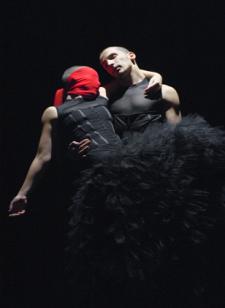
Trisha Dunn, Derrick Amanatidis, Mercy: a dance for the forgotten
photo Michael Rayner
Trisha Dunn, Derrick Amanatidis, Mercy: a dance for the forgotten
Four years of war in Iraq, Guantanamo Bay and web broadcasts of torture have made us familiar with horror inflicted in the name of belief or public safety. Unfortunately, we too easily visualise that hostage with a bag over his head, being threatened on grainy video. New Zealand choreographer, Raewyn Hill has devised Mercy: A Dance for the Forgotten for TasDance. The work, exploring ideas of imprisonment, torture and the strength of the human spirit, was born of a visit to Port Arthur and a book by Margaret Scott about the massacre there in 1996.
From the first moment of Mercy a powerful aesthetic is revealed. A bell peals, like a call to prayer and four dancers are shown face down in each corner of the stage. Each is contained in a hazy cone of light that forms a rectangular cell on the floor. Red bands of elastic run from their prone hands and feet to the heights of the fly tower. As a recording of Pergolesi’s Marian Vespers swells around the audience, a sole female, in black corset and delicate ruffled skirt, falls and twirls in the space made between the red lines. It is a scene that is visually striking, sensual and ambiguous. While the solo dancer is obviously imprisoned, it is difficult to ascertain her state of mind from the flowing, rolling gestures.
As brief scenes progress, the aesthetic vocabulary is consistent and ambiguity lingers. Each corseted dancer is affected by some form of torture as the glorious voices of the Pergolesi fill the auditorium at a constant intensity. Amidst the stylised horror, a love story emerges between the leading dancers. These sequences between Trisha Dunn and Derrick Amanatidis shine with a sense of fragile, tender connection, built around cradling and carrying.
Mercy stems from a very genuine engagement with the idea of imprisonment. The emotional connection to the material is clear from Hill’s statement in the program, but I can’t help thinking that the dance needed to go further, to dig deeper. Having once spent several weeks visiting concentration camps in Eastern Europe, I expected to see more of the complexities of imprisonment in this work. Yes, there are definitely triumphs of the human spirit in horrendous circumstances, but there are also many questions around the potential for any one human to inflict cruelty on another. From my observation the triumphs are rarely grand gestures but more points of light in the dark—one person wrote a book on tiny pages, another made playing cards small enough to hide in the mouth. Gender, sexuality and personality are stripped in these circumstances, the body wastes, the spirit is heavy. Watching Mercy, a work of undeniable beauty, I couldn’t reconcile this knowledge against the sexiness of the costumes, the sensuality of the gestures, the relentless energy of the dancers or the uninterrupted formality of or the stylised production design.
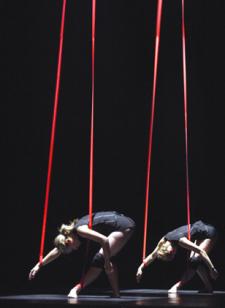
Mercy
photo Michael Rayner
Mercy
A single chiming bell pierces the black, smoke-filled theatre as four dancers lie face down on the stage; red ribbons run from the heavens, tied to a hand and a foot of each. The marionette dancers rise, bounce and twist under the fabric ties which appear to be lifelines, and at other times, binds. Later, red ribbons depict torture and bondage.
The idea for Mercy: a dance for the forgotten came to New Zealand choreographer Raewyn Hill after a visit to Port Arthur in 2005 and her subsequent readings of Margaret Scott’s Port Arthur, A Story of Strength and Courage. The work is an exploration of imprisonment, torture and pays homage to the strength of the human spirit in times of adversity.
Mercy’s stylistic strength comes from stark symbolic components – red ribbons and blindfolds are worn by the dancers who struggle against prison guards as they are led to their likely deaths. Chains, attached to male dancers are dragged noisily across the hazy stage. The costumes are black, tightly fitted corsets and large, layered skirts reminiscent of colonial underskirts. The lighting evokes prison life with bars and small isolated cells and downward lights creating, at times, a sense of a God looking down on the prisoners as they repent and seek salvation.
It is said in moments of struggle humans look for connection – often a physical one. There are such moments, but the audience is denied any fulfilling emotional journey alongside these convicts or prisoners. For a moment, love does emerge, between two captivating dancers – Trish Dunn and Derrick Amanatidis. They support each other’s bodies, caress gently and we know their love will never be fully realised in such a treacherous place.
At times the work is unrelenting in its motifs of oppression, however the mood achieved through the choreography leans more towards the abstract than the specifics of a monumental time in our national history. The work seems therefore to be limited conceptually and doesn’t achieve the promise of the program synopsis.
The musical score (Pergolesi’s Marian Vespers composed more than 250 years ago) is astounding, strong and impassioned and operatic – it seems to call the lost souls of the prisoners to the stage to repent and free their souls. Choreography and musical score are given a similar weight for much of the work and on occasion the music seems distracting.
Mercy is a stylish work, visually arresting with strong symbolism but perhaps too abstract in its treatment of its subject matter to be completely fulfilling.
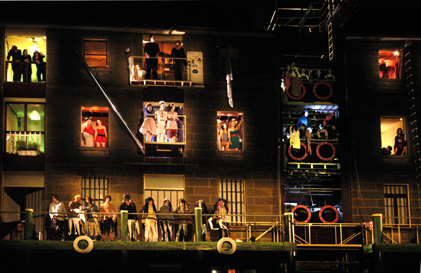
Dream Masons
photo Michael Rayner
Dream Masons
The highly ambitious production, Dream Masons, has been promoted as a headlining event in this year’s Ten Days on the Island calendar. Curiosity was roused as soon as the historic façade of the Salamanca Arts Centre began transforming weeks ago. Scaffolding, balconies, ladders, ledges and enormous drainpipes have been erected across several shop frontages, up four storeys and over Kelly’s Steps laneway, to form the set for this timeless tale of an apartment block, its inhabitants and their relationships with water.
There is the unlucky fisherman, the sailor and his lover, a landlady who hoards ice, a jilted bride who weeps over her washing and a debauched, liquor-fuelled party. There’s a newly arrived couple equipped with planter box, white picket fence and baby lamb ready to establish domestic bliss and there’s also a little boy. Meanwhile in the basement convict-like workers pump water up into the house above. We are given no formal introduction to the characters as there is no spoken dialogue. Rather, the protagonists are well-worn archetypes identifiable by costume as they appear in windows and weave in and out, up and down the façade via rope ladders, swinging walkways and a suspended rowboat, going about their idiosyncratic lives.
A great flood constitutes the story’s climax and necessitates a daring escape as the residents flee from rising waters to the topmost apartment. However the young boy is accidentally left behind and engulfed, only to be resurrected, recalling Jonah’s journey in the whale. The clownish fisherman ultimately helps the boy, saving the day in spectacular fashion, rounding off this whimsical tale with a happy ending.
Technically speaking, Dream Masons is spectacular. The use of water is impressive, as is the kinetic set. A beautiful lighting design by Daniel Zika creates a candle-lit effect across the sandstone facade and spotlights are well employed in assisting the audience to follow the action across this vast canvas. The layers of history visually represented by the floors in the Dream Masons’ apartment block resonate poignantly with the work’s siting in the mini tourist mecca of historic Salamanca Place. Despite occasional clumsiness, innovative use of image projection and shadow puppetry is used effectively to create visions of the underworld. However the distance between performers and audience makes following the plot somewhat challenging.
Pace and dramatic atmosphere are developed throughout the show by a live instrumental ensemble and The Southern Gospel Choir, the latter covering a number of frustratingly obvious popular songs with references to water (Bridge over Troubled Water for example). The performance of Leonard Cohen’s Hallelujah seemed rather tactless given the nature of the demise by drowning of Jeff Buckley, the best known interpreter of the song.
Appropriating Tasmanian waterscape photographs such as Dombrovski’s historically significant Rock Island Bend as background for banners that introduce scenes is also problematic. These images simply joined the plethora of water references in Dream Masons ultimately muddied meaning.
There is little subtlety to be found in this spectacular performance, perhaps because of the complex logistical objectives of the project. For me, the most poetic moment came when I noticed the Pacific Princess cruise ship serendipitously docked at Hobart’s waterfront parallel to the Salamanca Arts Centre. With its portholes alight it beautifully embodied Dream Masons’ tale of a dwelling supported by water.
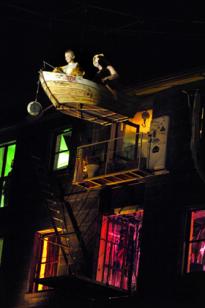
Dream Masons
photo Michael Rayner
Dream Masons
To the oom-pa-pa of the band water cascades from the stage, shadow-puppet fish swim in the windows of Salamanca Arts Centre, a boat floats above the street audience and performers climb ladders and moving ramps on a uniquely vertical stage. These impressive theatrics leave you smiling. Dream Masons is worth attending just to observe the amazing set design that turns the façade of the Arts Centre into a stage with unlimited opportunity.
The rigging is fantastic: ramps appear out of nowhere allowing performers to scale the building; a washing line strung between windows allows a performer to swing from one to another; and skilful wiring allows a fisherman to row in mid-air. Projections and shadow play reveal scenes and sub-plots further accentuated by the deftly changing music score as each window lights up.
Mood is largely dictated by the music and lighting, and most of the characters are defined by their musical accompaniment. The excellent small cabaret-style band, comprising tuba, drums, keyboard, bells and accordion, generate the ominous quality of a scene with a whale that would make Hollywood directors jealous. And many members of the audience cannot help but bop to the more upbeat music.
The building is populated with clown-like stereotypes: the helpless bourgeois lady in a wheelchair, the woman hanging out washing and yearningly holding up a wedding dress; the muscular sailor showing off his strength to a ditzy girl; and the ‘old hag’—a woman with a hunchback. The characters visit or intrude on each other or party—until the plumbing goes wrong. This is where the production comes to life. The building is flooded, resulting in an evacuation to the top storey providing suspense and interest so far lacking in the production. The water rises, fish and shadowy water demons and finally a giant whale appear, impressively filling the windows of the entire façade.
After the initial introduction to the building and its inhabitants, large banners had been unfurled to announce the five chapters of the story, revealing the production to be an allegory of the flooding of Lake Pedder. (Really! What did the first part of the production have to do with this?). For me Dream Masons relies a bit too heavily on glitzy stunts and theatrics, dated gender stereotypes and a trivialising of the Lake Pedder disaster to form a coherent and convincing story. However, the design, with its vertical staging and clever use of windows, rigging and lights was fantastic; so let’s hope that this approach is used again in the future in a more coherent production.
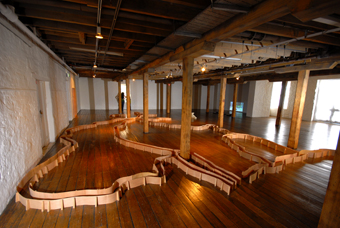
Lucy Bleach, Circumnarrative
photo Craig Opie
Lucy Bleach, Circumnarrative
A low wooden structure snakes around the pillars of the Long Gallery. A series of plaques on the wall proudly display fragments of local roads. An easily missed lightbox hides outside the gallery window. This is Lucy Bleach’s Circumnarrative.
The wooden structure is probably the most puzzling of the three works. Two parallel lines of 10cm high plywood curve around the timber floor forming the likeness of a walled road or some other passageway. It dodges the gallery pillars in a way that a plant would, the organic nature of its movement suggesting that nature may have been an inspiration. Yet it still looks very much built, with its exposed supports and its likeness is to roads which track a journey through what appears to me to be the gradually evolving shape of Tasmania. I strain to remember the locations of the roads I have travelled in my own short time in the state: Eaglehawk Neck, Burnie, Launceston.
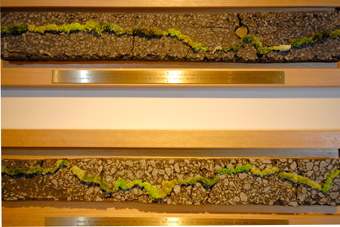
Lucy Bleach, Circumnarrative
photo Craig Opie
Lucy Bleach, Circumnarrative
The five plaques mounted vertically on the nearby wall each display a section of bitumen dug up from Hobart roadworks. Between the cracks, delicate green embroidery pokes out, just as hardy plants would amongst the urban landscape. Engraved professionally below each section on a brass plaque are the details of the location of the road, its coordinates, the date of the removal of the section, the names of the crew, as well as quotations from people involved in the works or looking on. These observations fight the cold objectivity of the plaques, some describing an experience relating to the road: an old man who named the particular crack in the road which he has been watching for many years “Nellie.” Other sentences are brutally honest: “Bumped into Pete Jenkins who watched the crew scraping back the road with me and told me Mary had lost their baby girl.”
The third work, the lightbox mounted outside on a neighbouring wall depicts a landscape view with a freestanding gate, through which can be seen the edge of the land over the ocean. Even without the gate, the typically bleak Tasmanian landscape would seem hostile; but the gate adds an extra physical barrier to the land. It is also cleverly placed out of reach in the space between the buildings—an island of colour and light against the sandstone wall.
Circumnavigate is an initially incohesive work, but on closer reflection, the three parts share an underlying theme. I perceive an outsider’s view of Tasmania. As with many small communities, Tasmania has a cliquey nature that many newcomers to state find initially alienating and hostile. Perhaps, coming from Sydney, Bleach has experienced this ‘outsider’ phenomenon. The wooden structure may suggest the roads of Tasmania, but also a sense of exclusion: these ‘roads’ are created out of relatively tall barriers, preventing not only entrance but also escape. The wall plaques share with us intimate comments, but are presented in a strangely objective manner, suggesting the view of another kind of ‘outsider.’
Circumnavigate is beautifully mysterious: the structure which evolves as you walk around it and consider the shape of the whole and the journey within; the intriguing plaques with the fleeting stories of ordinary Hobart workers and the overlooked remnants of their efforts made permanent; and the landscape, sectioned off twice in a bid to keep out the stranger. It takes time to enter Lucy Bleach’s work, however the reward is coming to a unique understanding of Tasmanian as ‘an other place’.
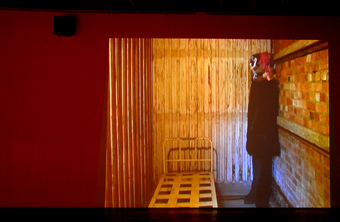
Austin McQuinn’s Bogeyman
photo Craig Opie
Austin McQuinn’s Bogeyman
There’s a neverending conversation in much artwork that emanates from Tasmania and is about Tasmania, which is about This Place (a current local advertising campaign virtually orders us to Love This Place!) that was eventually named Tasmania, after being Van Deimen’s Land for a period of time, and presumably had an Indigenous name before that. There is a particular sensation that the place seems to evoke, formed by distance, being dwarfed and awed by a landscape huge and even intimidating. The South West Forest (possibly the most internationally well-known part of Tasmania) was named Transylvania on early maps, setting into motion a strange unnamed kind of Tasmanian Gothic that has dominated much artistic production here ever since.
Austin McQuinn’s Bogeyman offers a particular vision of this place, a vision of Hobart, that is familiar and Other at once. A video projection introduces us to an odd figure constructed from dark cloth that covers the entire body except for the head, which comprises a clump of those old woollen CWA toys made into a slightly sinister amorphous blob. Interestingly, the use of old toys is fairly common round here, due in part to the presence of the Resource Tip Shop. The regular Art From Trash exhibitions usually feature something like the Bogeyman’s headpiece. But there’s more to this Bogeyman than his appearance.
He wanders out of place, pathetic and forlorn through regions that for me are rich with personal memory. I know the region of the mountain Bogeyman stands in, the steep street in South Hobart he carefully feels his way down, looking ever more awkward and displaced. I know which courthouse he’s been in, and I wonder if his story is formed in part by the sad tale of the Irish political exiles that ended up here. The guy who made the work is Irish after all, and for the purposes of this exhibition, the Irish are apparently Other as well.
So, the Bogeyman is alone in a place that I find so familiar. He doesn’t have my local know, is blind to the resonance and ripples that he creates, re-writing the landscape with his small presence. It’s a landscape he’s removed from—he can’t see, all his sensory equipment muffled by the thick black costume and the heavy headdress. He’s been made that way—he is a construction.
I see the places he’s in as some of the most obvious places an outsider would go when they come here; then I wonder if I’m being smug and insular. Maybe. Maybe I’m tired of the same story of this place being told by those from outside it. That’s if it is the same story, but if it is not, why do I recognise it? Even some things about the Bogeyman seem familiar. The way he seems to be put together, made out of residue, discard and children’s nightmares. I’ve seen him before somewhere; somewhere here. He’s unfamiliar and yet sympathetic in his lonely plodding. And I do think of him as character, yes, somehow. Somehow he takes that on in this work, bringing me back to where I sit, staring at him, wondering if his mere presence has re-written my home town even for me. I watch him sadly slide under a bed that no one sleeps in anymore.
That’s it. He was under my bed. He was under yours as well. Remember?

the write/here project
photo Justy Phillips, James Newitt
the write/here project
I’m walking through my city and I discover that something fundamental has changed. The jangle of multi coloured advertisements, with all of their enticements, have been replaced by personal messages, thoughts and musings. I stop and wonder at the text that I see. I find myself agreeing with “Sometimes you make your own traps” and asking myself what is referred to in “Could be magnificent.” This is the urban experience that Justy Phillips imagined when developing an idea for a short film some years ago.
What evolved from the original idea is a massive public artwork developed in collaboration with fellow artist James Newitt, transforming Hobart for just two weeks.
The write/here project strips 27 bill board spaces around Hobart and re-skins them with pieces of text shown in a white, sans serif font on a lush red background. The text originates from 1000 responses to workshops, exhibitions and individual interviews with residents of Hobart. People were asked a range of questions about the place they live in, including “What does Hobart mean to you?”, “Do you have any regrets?”, and “What are your hopes for the future?” The artists selected the final texts to provide a range of responses that retained enough ambiguity to allow viewers to establish their own interpretations.
While there is only spelling, syncopation and choice of phrase to define their voices, the text is seeded with clues that reveal the contributors as diverse in age, experience and country of origin. One board evokes the sadness of old age, “So many of my friends are dead now”, while another suggests the voice of a prisoner or care home resident: “It’s my own space but sometimes I feel I’m trapped in a cage. 6.30 is too early for goodnight.”
With the spread of boards around the city the write/here project is seen in a range of contexts that have a bearing on both the interpretation and the effect of the text. A poignant note about a highway death at the head of the Southern Outlet is likely to leave motorists pondering their own mortality and “Hobart means home, but you can’t spend your whole life at home” is a prompt for those leaving the airport to think about where they have come from or where they return. There seems to be a tendency toward texts that depict Hobart as something other than a peaceful, picturesque tourist destination and some of my friends have reflected that the overall effect is too melancholy to fit with their impression of their city.
Visually, I enjoy the aesthetic of the boards that use the colours of advertising but are stripped of any extraneous information. The clarity of this effect is pleasing, particularly when seen across a collage of windows, roofs and satellite dishes.
The write/here project is clearly a work mediated by the artists, but their touch is light enough to ensure that it is still an expression of a community. There is a lovely sense of relief in seeing meaningful, truthful statements on these boards rather than wildly exaggerated claims or threats that life won’t be complete without a particular product.
Another account by Judith Abell will appear in Landscape Architect Australia, May 2007
the write/here project, curators Justy Phillips, James Newitt; billboards around Hobart, Ten Days on the Island, March 23-April 1
RealTime issue #78 April-May 2007 pg. web
© Judith Abell; for permission to reproduce apply to realtime@realtimearts.net
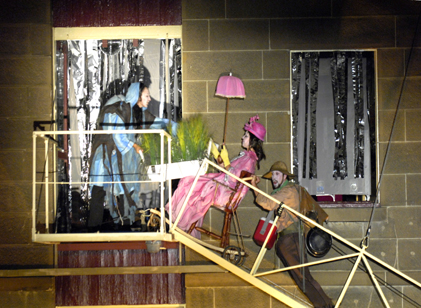
Dream Masons
photo Michael Rayner
Dream Masons
For the last month I’ve been walking under a jetty to get my morning coffee. I was oblivious to my underwater journey until Dream Masons exploded over the face of the Salamanca Arts Centre with a spectacular display of mechanical wizardry, bawdy hijinks and vaudeville-style theatre.
Dream Masons was commissioned as a celebration of the Salamanca Arts Centre, a place that has housed and supported Hobart’s creative community for thirty years in a jumble of linked sandstone warehouses. The buildings themselves are the stage for the work which is performed across the vertical surface of three buildings over four storeys. Twenty windows were utilised and the entire facade was fitted with scaffolding, rigging, ladders, a twenty metre long bridge, a boat on a rope, three balconies, a fridge and a toilet. And of course, my jetty.
The windows depict apartments within the building occupied by a mixed bag of tenants. The characters are easily recognised types played out in with vaudevillian overacting, repetition and an abundance of sight gags. We meet the hapless fisherman, the bawdy babe, the strong-man sailor, the henpecked husband, the prissy wife, the weeping spinster who is always washing and a boy in a Superman suit. Living at the top of the building, hoarding ice cubes like currency and screaming through a loud hailer is the cantankerous hunch-backed landlady. Each of these lives is highlighted through the changing focus across the facade as windows are illuminated in turn.
Gibberish aside, there is no dialogue and the plot is deceptively simple. Each of these characters goes about their lives until disaster hits. A great flood—possibly created by evil means—threatens their building and the group help each other to escape to the apartment of the unwelcoming landlord. The weeping spinster makes a dramatic escape across her clothesline to safety, but the boy is lost in the waters and eventually swallowed by a whale as big as the whole building. Saved by his snorkel, the boy spectacularly finds his way out through the whale spout and saves the day by releasing the waters.
The main players are backed by a cast of extras, a large band, giant banners to announce the main episodes of the story, a gospel choir and a busy backstage crew whom I imagine running madly between buildings throughout the work. They fill each window with back projections, creating the rising water and the huge whale which are highlights of the show.
While it is easy to take the show at its cheesy face value, anyone who has ever had anything to do with the Salamanca Arts Centre will know that Dream Masons is like taking the place and turning it inside out so that all the melodrama, personalities, politics, shoddy construction and leaking roofs are all revealed on the outside for one hour of madness. I’ve often thought the place was ripe for a multi-storey sit com, but this show goes ten steps further and I now wonder if the centre was also a hub for the protests against the Lake Pedder flooding which is hinted at as a parallel disaster in the show. I clapped and laughed like a seven year old, but also enjoyed Dream Masons as a regular of the Salamanca strip and I will miss those underwater coffees over the weeks to come.
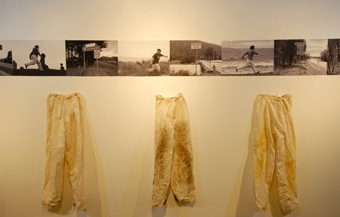
Julie Gough, We Ran/I Am
photo Craig Opie
Julie Gough, We Ran/I Am
How do we experience place? How much can we ever understand of a foreign place? If we read the signs will they tell us the story? These are questions that arise in experiencing works by Julie Gough and Austin McQuinn in AN OTHER PLACE.
Julie Gough’s work We ran/I am is composed of a series of black and white photographs matched against pairs of rough-sewn wool and calico trousers. The trousers hang as physical evidence of the photographic content. As the artist is documented running through the horizontally mounted images, the trousers underneath bear different levels of soiling that could reflect falls to the ground or lost footing. A map mounted on the side wall shows the marking of the Black Line, part of a notorious campaign in 1830 by Lieutenant Governor George Arthur involving a moving chain of Tasmanian residents intended to round up all Indigenous islanders, most of whom would eventually die as a result of imprisonment and disease. Interspersed between the active images are stills of the tired signposts welcoming travellers to towns along the Line with the standard claims about being “Historic” or “Tidy”. As an adjunct to her title, Gough quotes a journal entry from George Augustus Robinson: “The people all seemed satisfied at their clothes. Trousers is excellent things and confines the legs so they cannot run.” (sic) In similar trousers, Gough relives the escapes of her ancestors.
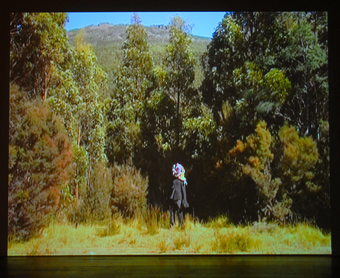
Austin McQuinn, Bogeyman
photo Craig Opie
Austin McQuinn, Bogeyman
Austin McQuinn’s work also journeys through a series of places, but with a different kind of energy. Bogeyman is a wall-sized video projection with a five minute loop showing a series of locked shots of Hobart. Coming into the work at a particular point I was confused by the intent as it flicked through a number of shaky views of Hobart backed with questionable sound. Almost to the end of the fifth shot, my patience waning, his Bogeyman appeared. This creature is presumably the artist or a projection of McQuinn, dressed in sagging black knit pants and top, hands and feet encased in what could be mittens. His head is completely covered by a headdress of knitted toys. The figure is both pathetic and absurd as he walks slowly through each of the shots from the top of Mount Wellington to a single cell within the old Hobart Gaol. In what could be the final shot, he disappears under the bed, like the bogeyman of childhood.
Together these works address a condition that I believe is intimate to Tasmanians and visitors—the sense of experiencing, but perhaps not understanding the place you inhabit. Gough’s work reveals a dark layer of Tasmania’s past that makes a parody of the “historic” in the worn out welcome signs within her images. Her Tasmania is definitely “an other place” from the pristine island that we see in the advertisements and its people are to be feared. McQuinn’s figure also reveals an experience of distance from the landscape. I imagine that his moping monster represents the artist’s feeling of isolation as a resident of Ireland attempting to make work in a foreign place, walking blindly through a landscape he may never understand.

Robert Jarman, The Spectre of the Rose
photo Carolyn Whamond
Robert Jarman, The Spectre of the Rose
They called me a thief. I was innocent. They called me a thief, so I decided to be a thief. A false accusation at the age of ten may have been the first defining moment in the chequered life of Jean Genet, French playwright, political spokesman and hero of the Existentialist movement.
These words are uttered in disgust and defiance by Robert Jarman as he plays Genet in a solo show entitled Spectre of the Rose. The show is staged in Backspace where a small audience is party to the confidences and musings of Genet from prison. His cell is defined by a brick wall at the rear, a sleeping bench, a few personal possessions and a strong white line marked out on the floor. Throughout the work, Jarman remains behind the line, even while leaning his body out emphatically toward the audience.
The show begins uncomfortably. Genet is prone on his bed, placed centrally in the cell. He is clothed in pants and singlet that are thin and holed. Low restless music accompanies his breathing for an indeterminable time and he seems to be struggling with thoughts or nightmares, his body stiff with tension. I sense the spring of a dancer in this man and as if to prove this Jarman’s Genet leaps from his bed and begins his monologue like a ranting madman. He runs around the cell, listens at the wall and is wide eyed as he describes the voices of other prisoners that surround him—some murmured, some screamed, some inaudible. He climbs up high to listen and runs laps around his bed describing the ritual of the discipline yard where men are forced to continually run in a torture that is accompanied by the indignity of defecating in a can in full view of the others.
Once Genet has articulated his dreadful circumstances he quietens and begins to explore his thoughts. It is now that he makes sustained eye contact with audience members and there is a sense that he has decided to trust us. We are his confidante.
Genet’s imagination is rich and dark and perhaps that is how he survived lengthy incarceration. He appears to have the capacity to build relationships with imagined foes and lovers to the point where the heights of experience with those he selects bring him a kind of satisfaction, sexual or otherwise. He shares his heroes with us—they are murderers whose faces he has pasted to a board concealed in his room. He is excited by their crimes. As he says, “The only way to escape horror is to bury yourself in it.”
This portrayal of Genet reveals a complex man. While I believe that we are expected to feel some revulsion at his delight in the worst of human behaviour, Jarman’s Genet is also tender and loving. As he describes his relationship with a fellow prisoner and re-enacts an afternoon of slow dancing in a cell—the only permitted form of affection—the depth of feeling, the love, the grief for this lost love is very moving. To some extent, he is a slave to his own desires and we witness the inability to gain distance from his turmoil culminating in self mutilation. Perhaps this is the inspiration for the trilogy of which this play forms part—Prisoner of Love. Seeing the show is a visceral experience that could be confronting for some as it involves blood, nudity, masturbation and simulated fellatio, but beyond this are moments of lucidity and stunning observations that inspire reflection on the condition of being human in such extremity. Seeing the show is a visceral experience that could be confronting for some as it involves blood, nudity, masturbation and simulated fellatio, but beyond this are moments of lucidity and stunning observations that inspire reflection on what it might mean to be human in such extremity.
Hobart’s City Hall has been transformed into a caravan park. Inside the corral of five crusty old caravans, chairs and picnic rugs face a small stage and a screen. We have each been given an esky filled with surprising gourmet products—confit of scallops, sugar and grapefruit cured ocean trout, and smoked wallaby. Not your standard family picnic fare. But then, there is nothing quite standard about Big hART's Drive In Holiday.
One caravan serves as technical hub and radio station from which the actors keep us informed about what we are eating, what to do and where to go. The other vans house installations representing four Tasmanian coastal townships. The Crayfish Creek van is particularly engaging as every surface including the vinyl seat covers and the internal surfaces of the cupboards, is postered with naïve illustrations by Rebecca Lavis. She has even created a photo album to flick through and decorated blocks and a jigsaw to play with. The Tomahawk van has illustrations by cartoonist Reg Lynch glowing on a lightbox above the sink while Euan McLeoud’s acrylic and oil landscapes adorn the Trial Harbour van. For Southport, Christine Kilter has created a haven for kitsch with crocheted cushions, gaudy figurines and a series of snowdomes with pictures and stories from the area. The vans are intriguing and warrant time to absorb but we are instructed to return to our seats, or picnic blankets to watch the show.
While we sample our exotic edibles a duo sings a sweet and melancholy acoustic number and the “movie” begins to roll. We see a woman, Crystal (played by Kerry Walker) through the window of a caravan. Surprised by the appearance of a police officer, she chokes on a piece of food. There is sharp edit, and we realise that the action is now live, being filmed in the Couta Rocks van to our right. We can choose to watch the live action surrounded by a young crew holding boom, camera and lights, or we can view the action on screen. This is a movie in the making.
Pre-recorded footage offers the unhappy back story of divorce, custody loss, and a sea change. In a live scene in the van a gentle friendship between Crystal and Keg (Lex Marinos) unfolds as she helps him write his will. Back to animations and prepared material and the tale of a freak discovery—a human toe in the guts of a fish. Then we switch back to a repeat of the live scene as a policeman delivers Crystal the message of her ex-husband’s unfortunate demise.
And this is just the beginning. It’s a mini-series and the drama continues to develop, using a connection to Keg as the binding agent and taking in the towns we have experienced via the van installations. We meet a young girl, his niece (Dawn Yates), playing a piano in the middle of the bush at Southport, her mother with Alzheimer’s (Kerry Walker) in Tomahawk and eventually there is a love story in Crayfish Creek (or is it Trial Harbour… I’m a bit lost now).
As with all of Big hArt’s work, Drive In Holiday is made as part of a larger community development project, so in addition to appearances in the fictional material, local people are included in brief documentary segments telling stories and recollecting details about their towns. The fictional scenes that follow illustrate how this is incorporated into the narrative.
The shifts between live and set footage gradually break down, the switching between lines of recorded and live dialogue becoming unwieldy. The actors abandon the filming scenario and simply stand on the stage reading from their scripts. Originally I suspected a technical hitch as Marinos receives instructions from the blue-coated floor manager but, as the actors are directed to play the scene as though it were a soap opera, the mock rehearsal reveals another layer of artifice. Again we are reminded that this a story, and a story in the making.
And the story is not finished. As the show progresses the initially tight hold on the narrative begins to unravel. Some of the imposed details and fragments of stories from the community are not completely woven into the plot but rather just hang there, perhaps waiting for the next episode. Why does Crystal take the name of her deaf and dumb sister? And the rapidly developed lesbian love story seems expedient. In the end we are left with another gentle sweet song and an ambiguous kiss.
The scale, complexity, and the integration of interdisciplinary elements in Drive In Holiday is very impressive, and the environment created is completely immersive. However there are are a few elements that niggle. The overwhelming nostalgia of the content—a golden era of baby boomer Australian kitsch—is curious considering the material was developed with a workshop of young mothers and their children. And within this atmosphere, the gourmet food, although thoroughly enjoyable, might more appropriately be replaced by a sausage sizzle. The material does also seem to thin out, as the work progresses, less integration of live elements and more scattered plot devices. Despite this Drive In Holiday is a unique and thoroughly engaging exploration not only of a slice of Tasmanian culture, but of the potential of hybrid performance and expanded storytelling.
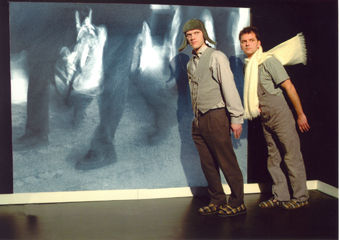
The Little Match Girl
photo Jan Rüsz
The Little Match Girl
A strongly familiar story that deals with the cold and lonely death of an innocent girl might seem to be a strange choice for a piece of children’s theatre, but then again, perhaps discussing such a difficult topic is exactly what we need from theatre. It’s a brave thing to even attempt, so a great delight to experience something that must have been so difficult that achieves as much as Denmark’s Gruppe 38’s production of Hans Christian Andersen’s The Little Match Girl.
Children’s theatre has different concerns from its adult counterpart, and there’s a common assumption that the performance has to be responsible for the emotional wellbeing of the younger audience. Given that both story and outcome, are well known, the nature of this responsibility looms large, and the company’s reaction to this has shaped the nature of this production in quite particular ways. From beginning to end the cast are visible, and they acknowledge the audiences’ presence. The set, and general appearance of the performers has a hint of genteel poverty, which gives the whole thing a clownish, unthreatening quality. The performers use their own names, introduce themselves to the audience, have their roles explained and produce ‘scripts’, which are not scripts in the traditional sense but images. All perfectly elegant and deft deconstructive moments, and indeed there was much of this throughout the performance: a piece of paper being moved about with a long thin stick to create an illusion of wind is eventually grabbed, revealed as a long thin stick and not wind at all. It’s an illusion. It looks amazing but it’s not real. It’s just a story you’re watching: we’re reading it from scripts, using clever theatrical tricks; you can see us using them. It’s all right. It’s fine.
The set, stark and simple, utilizing projection in many ways, had one particular premise that fascinated – the performance took place within a smaller square on the stage, that was clearly defined early on as a dangerous place to be. Performers entered it at their own risk, a little nervous but with brave hearts. They would take whatever risk necessary for their story, unselfishly keeping the audience a little safer still.
It’s not always dangerous in the space however; a simple projection onto a shoulder-high silhouette of a four-storey townhouse is raised from the floor giving the performers a chance to create images of warmth and food and comfort. It’s all done with a small projector, visibly worked by the performers. It’s all an illusion; it’s not real. We are telling a story. This is how we are telling it, using these clever little things that are simple and easy to use. What’s extraordinary is how many of these things there are, and how much is evoked by their clever, economical usage.
I found this work extraordinarily satisfying. It was everything I look for in strong theatre – intelligent, even witty use of theatrical devices that do not overwhelm or cheapen the story and its attendant emotional resonances. The energy that was created, controlled and shared was very involving; I was caught up: charmed by the way the company told stories and moved by the story they told.
Do you know the type of sound which massages the back of your skull? No? Yes? Well… it is my best attempt at quantifying the intensity of sound that Leigh Hobba managed to create in his performance at the Tasmanian Museum & Art Gallery. I tried to keep my eyes open to the shadows, the video images and the live dancer but it occasionally became necessary to lull in the pulsating sounds of Hobba’s clarinet playing and avoid sensual overload by just closing them.
Leigh Hobba is a performance, sound and video artist who announced this event as a “distillation of 20 years work”: favourite performance pieces dating back to 1976. As one of the younger members of the audience, I had never seen any of these so I had no idea what to expect. In the darkened room, two wide screen television monitors sat on each side of the stage, and on a plinth next to the microphone and music stand, a tiny monitor blinked with static. From behind a black curtain, an elongated shadow of the clarinet spreads across the white wall, the monitor revealing what I finally decide is Hobba's pulsing stomach. He alternates between repetitive, modulating series of notes and the bending of long single notes. The effect is ultimately spine chilling. Combined with the rhythmic tapping of the keys, Hobba’s desperate breathing—due to the pressures of continuous playing and circular breathing—and the ever present shadow provide an almost overwhelmingly sensual introduction to his work.
Hobba’s collaborator, Wendy Morrow, enters the room as the sound ceases. My view of her is blocked so, as with the introduction, I am captivated by her shadow. The quiet that follows Hobba’s work fills with dancing until Hobba returns and reads text, accompanied by images that flash up on the various screens: a young boy acting out a brief movement routine, a baby curled up, the jet trail of a plane and the flags of nations fluttering in the wind with repetitive flag pole clanking.
Later that night, when I am sitting through a different performance, A 1000 Doors, A Thousand Windows, I am struck by similarities in the projections, the use of digital sound distortion and the hypnotic effect created by repetition. Hobba calls his work performance art, and Xenia Hanusiak, the singer and co-creator of A 1000 Doors… calls hers music, but both challenge the traditional boundaries between visual art and music.
Leigh Hobba’s performance created a sensual environment that was almost overwhelmingly magical and evoked a strong emotional response, an experience not dependent on prior knowledge of his work.
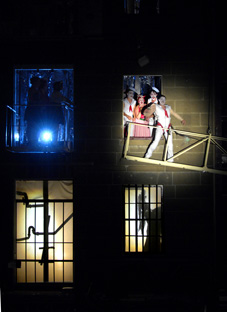
Dream Masons
photo Michael Rayner
Dream Masons
One of Hobart’s beloved landmarks is the stage for a festival extravaganza, one that could not be contained in a theatre or gallery space. Ten Days on the Island wouldn’t feel a complete festival without the outdoor theatre spectacle, Dream Masons.
In Australia, there is a tradition of labelling large-scale outdoor productions ‘community works.’ This often translates to loads of ‘emerging’ community artists working for no money in exchange for ‘training’ from ‘professional’ artists. Dream Masons is not a community work. Expert artists have been sought from the US (co-director Jim Lasko) and the ‘mainland’ (Joey Ruigrok Van Der Werven on design and construction) to work alongside many exceptional local professionals (co-director Jessica Wilson and Tania Bosak, Justus Neumann and Ryk Goddard). Dream Masons has also provided a training opportunity for many budding theatre technicians from the Salamanca Arts Centre’s SPACE course. All of these artists and more and many volunteers have collaborated on the transformation of the Salamanca Arts Centre buildings, making Dream Masons a truly site specific work.
The inhabitants share this liquorice-all-sort of a building and speak in gibberish, howling, laughing and accosting each other as they dance over three levels of the Salamanca Arts Centre façade. Their introduction is perhaps a little uninspired and drawn out but includes some considerable aerial feats. All have white faces with comically exaggerated, doll-like features. A hunchbacked landlady who collects rent in the form of ice cubes, a weeping widow who washes clothes in her own tears, a virile sailor who gets the girl and a confused fisherman are some of the motley crew we meet.
A team of volunteers create vivid underwater scenes with shadow puppets and an amazing whale using old-school overhead projectors. A live band and choir confidently belt out a water-themed repertoire, finishing with Bridge Over Troubled Water.
Large painted banners of popular Tasmanian landscapes are unfurled revealing summations of the action: “The Problem Deepens: a tipped bottle, a never-ending sponge and the sad demise of the overlooked.” They are a little unnecessary and, if anything, tend to confuse rather than add to the story.
The plot however is simple, the premise of the work a kind of cleansing in which a young boy is the catalyst for change and a symbol of hope. As the building and indeed world are flooded he is swallowed into the belly of a gigantic whale to be later ejected from the whale’s blow-hole—depicted by an impressive jet of water shooting out of the arts centre’s roof. With the help of a fisherman suspended high above us in his boat, the boy wields the wheel that will turn a giant tap and purge the building of water. And so he becomes the hero of the story.
Like the characters, the scale of the production is BIG and the big audiences are young, making Dream Masons a refreshing and unique addition to the Ten Day’s festival program
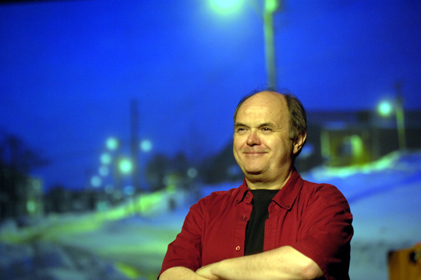
Andy Jones, To the Wall
photo Michael Rayner
Andy Jones, To the Wall
A pulpit and priestly vestments await Andy Jones on the stage. Religion is almost a compulsory subject for comedians today so I am not in the least bit surprised. As the spotlight focuses on the short, stocky and balding man, Jones takes on an evangelical persona and quickly establishes the character of the show.
Describing his Irish Catholic upbringing in Newfoundland, Jones colourfully re-enacts a ‘psychotic’ priest, childhood memories and the odd Newfoundland-Irish character with the help of projections. He calls a meeting in the theatre to which he invites God, suggests new additions to the human body (such as sexually attractive thermostats making visible emotional fluctuations), and uses a Newfoundland beef bucket as a metaphor for the randomness of life and the universe.
The premise of the show is that Stephen Hawking has a theory of the universe, however Jones has a better one. So in a one hour show Jones backs up his evolving theory with evidence. This is hard to follow at times with Jones’ liberal borrowings from scientific language, rabbits, randomness, throwing beef buckets of sand to form perfect maps of Newfoundland and Labrador, and finally the formula “TBP (Teddy Bears Picnic) = x [to the power of u to the power of u]” which supposedly created humans.
Funnily enough, many of his arguments seem logical and convincing, thanks in part to his charismatic personality. In fact, at the end of his psychotic priest impression, when he makes the sign of the cross, he is so convincing that a woman seated in front of me is compelled to follow.
Jones’ theatricalised standup formula is amusing, although at times he
crosses the line into ‘dirty old man’ territory, focusing on projections of female breasts, lusting over the young girls who are his onscreen assistants and making desperate ‘mating’ jokes—especially tiresome after he hands a gift of chocolates to a female audience member willing to confirm his sexism.
Despite these flaws and uninventive use of screen projections, Andy Jones educates a willing audience about the finer points of Newfoundland and its eccentric culture (and the fact that it is built on a rock). He’s convincing as an actor, and the vivid theatrical moments are easily the most amusing parts of his performance. Andy Jones did not make me laugh ‘til I cried, but To the Wall was a unique and entertaining introduction to an island culture on the other side of the earth.
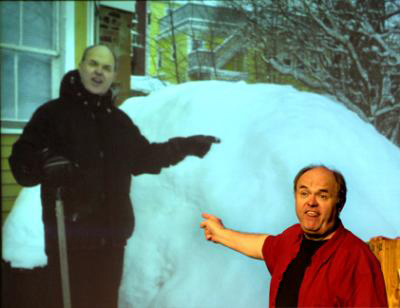
Andy Jones, To the Wall
photo Michael Rayner
Andy Jones, To the Wall
What were you doing when you heard about 9/11? Andy Jones was working on his theory of the universe, and though a self-proclaimed atheist, he prayed to God. And like many of us after these events he was left asking ‘Why?’ What God would allow such a thing to happen? Why are human beings able to inflict, and suffer, pain and misery? Worse still, why are we able to imagine such awful possibilities? These questions lead to his current thesis, delivered in the irreverent and humorous self-devised solo performance To the Wall.
Inspired by the popular writing of Stephen Hawking, this is a journey of amateur philosophy, theology and science. All the big questions get asked, and yet Jones finds many of his answers in the parochial tales from his own family history and their long involvement in the town of St John’s, Newfoundland. His overactive imagination is as ever expanding as the universe itself, seeming to drag everything and anything into his vortex of “N factor” reasoning (Newfoundlanders apparently do everything slightly different from everyone else).
The set is simple yet a little bizarre. There is a desk covered with a piece of crushed velvet, a ‘salt beef’ bucket, an old desktop computer, a wardrobe full of priestly vestments and a gold-detailed podium. Collectively they do not create a setting so much as provide Jones with a selection of props used at various points to elucidate his ramblings. The bucket for example aids Jones’ metaphor for chance: “How many times would you need to throw a salt beef bucket filled with sand to create a perfect image of a map of Newfoundland?” Image projection is used to similar ends with Jones’ wonderful family photographs from the early to mid 20th Century, epitomising the microcosmic dimension of his metaphysical investigations.
The intensity of Jones’ narration played on the anxiety I have experienced when cornered by a talkative boozer at the pub, or when a relative reaches for their photo album. It’s the fear of getting stuck in somebody else’s reality. Jones has studied the techniques of Newfoundland’s Irish Catholic preachers, and the ‘priest gone mad’ strategy has clearly influenced his own performance style. It’s akin to stand-up comedy, even Jones’ appearance—middle-aged man in nondescript black outfit with loud, open shirt—pays homage to this genre.
Jones is very much an entertainer and audience participation is part of his act though no one leaves their seat. Questions were posed to us and I was pulled into hypothetical scenarios, called upon to support his nutty ideas by raising a hand or stamping my feet. I became embroiled in Jones’ world by being made to laugh. To the Wall has many genuinely funny moments, and though it deals with life’s hardest questions this is essentially a light and engaging play.
Apparently, God invented randomness in the Big Bang in the hope of indirectly creating a “lovable equal other.” Jones establishes this role for himself in relation to his audience. Theorising that humour is a biological method of exuding “non-specific attractiveness”, his ridiculous imitation of a bird mating dance doubles as metaphor for the courtship between actor and audience in the theatre. Deviation into sexual innuendo and quips about gender politics however constitute the least interesting moments of this otherwise intelligent show.
Unfortunately the conclusion was abrupt and weak. Jones issues God an invitation to join us in the theatre for a question-and-answer session. He doesn’t come, and in frustration Jones proclaims his atheism. God instantly strikes him down! Or, was it just that he tripped over the keyboard cable? Either way, through the resultant paralysis Jones’ belief in the almighty is renewed and the final scene is a conversation between Hawking and Jones, projected in text and ‘spoken’ through voice synthesisers, where they debate their different theories about the origins of the universe. As Jones himself says, we may be alone but at least we have science. However, all the effort of setting up his theory of the universe over the course of the performance never seemed to pay off. Perhaps, as with science itself, the point is that theories are not always about proving a hypothesis correct—the value lies in the journey of inquiry itself.








































